Customer feedback shapes great businesses. Whether you address it or not, feedback will come—through reviews, social media, support tickets, surveys, feedback forms or direct complaints. A frustrated customer might leave a negative Google review about long wait times, while a satisfied shopper might recommend a brand website to friends. But when businesses proactively collect and act on insights, they gain a competitive edge—improving products, refining experiences, and increasing customer loyalty.
That’s where customer feedback tools come in. These platforms help businesses gather insights across multiple touchpoints, analyze trends, and close the loop before issues escalate. From measuring Net Promoter Score—the gold standard for customer feedback and satisfaction—to gauging customer satisfaction with CSAT and customer effort with CES—these tools help businesses prevent churn, act on insights, and drive meaningful growth.
And in 2025, AI-powered feedback analytics aren't just "good-to-have"—they are essential. AI Sentiment Analysis, automated insights, and trends allow businesses to instantly detect customer concerns, prioritize issues, and take proactive action—before they impact retention and revenue.
With countless options available, choosing the right tool can be overwhelming. That’s why we’ve curated a list of the top customer feedback tools, evaluating them based on core features, AI capabilities, free plan limitations, and G2 ratings.
Let’s explore the best tools to capture, analyze, and act on customer feedback effectively.
TL;DR
- Customer feedback tools help businesses collect, analyze, and act on insights to improve experiences, reduce churn, and drive loyalty.
- NPS is the gold standard for measuring customer satisfaction, helping businesses turn feedback into actionable improvements.
- AI-powered analytics are essential in 2025, with features like sentiment analysis, automation, and real-time insights making feedback more actionable.
- Choosing the right tool depends on:
- Survey customization & branding (drag-and-drop builder, multilingual support)
- Omnichannel feedback collection (email, SMS, WhatsApp, website, kiosks)
- AI-driven insights & automation (sentiment analysis, workflows, case management)
- Ease of use, integrations, and reporting capabilities
- Advanced feedback tools offer powerful features like location-based CX tracking, deep CRM integrations, automated workflows, and customer journey mapping to provide deeper insights and automation.
- Some of the best customer feedback tools include Zonka Feedback, Qualtrics, Medallia, Inmoment, among others, each possessing unique strengths.
- Zonka Feedback stands out with its AI-powered automation, real-time alerts, and advanced reporting, making it the ideal choice for businesses serious about closing the feedback loop. Book a demo today and see how Zonka Feedback can transform your customer experience. 🚀
Fuel Growth with Customer Feedback
Collect real-time, in-moment feedback at all touchpoints in customer journey and leverage insights to transform the customer experience.

What are Customer Feedback Tools?
Customer feedback tools are far more than just survey software—they are essential systems that help businesses collect, analyze, and act on customer insights. Traditional surveys only gather responses, but modern feedback tools streamline data collection across multiple channels, uncover patterns using AI, and automate workflows to take action.
Without a structured system, businesses rely on fragmented feedback from support tickets, online reviews, or word of mouth—missing critical insights. A hospital might struggle to track patient dissatisfaction unless it collects structured post-visit feedback. A bank might lose customers over a slow loan process unless it surveys applicants after key interactions. An eCommerce brand might miss checkout friction issues unless it proactively asks shoppers about their experience.
Unlike traditional survey tools, modern feedback platforms help businesses:
- Capture insights from multiple channels—email, SMS, in-app surveys, website pop-ups, web widgets, tablets and kiosks, QR Codes, and WhatsApp.
- Analyze responses using AI-powered insights—detect sentiment, identify trends, and categorize common themes.
- Automate workflows and close the feedback loop—trigger alerts, send follow-ups, and take action in real-time.
These tools are also the backbone of any Voice of Customer (VoC) program, helping businesses turn raw feedback into meaningful improvements. By centralizing insights and automating follow-ups, they ensure that feedback doesn’t just get collected—it drives real change.
Why are Customer Feedback Tools important?
Customer feedback tools aren’t just for collecting opinions—they are a growth engine for businesses. By turning feedback into actionable insights, companies can continuously refine their offerings and improve customer experiences. Here’s why these tools are essential:
- Drive Business Growth with Customer Insights
Understanding what customers want, need, and expect allows businesses to make smarter decisions, optimize offerings, and increase customer satisfaction. For instance, a restaurant chain might notice a drop in NPS at one location and quickly investigate whether it's due to food quality, service, or wait times. - Reduce Churn & Improve Retention
Unresolved customer dissatisfaction leads to churn. Feedback tools help businesses identify pain points early and take proactive action before customers leave. A SaaS company might find that users are churning after onboarding due to unclear product instructions—by analyzing feedback, they can improve tutorials and boost retention. - Measure Long-Term Loyalty & Transactional Feedback
By tracking Net Promoter Score (NPS) for overall loyalty and collecting transactional feedback at key moments, businesses can build strong, lasting relationships with customers. A bank might use NPS to measure trust in its services, while a hotel can send a quick CSAT survey post-checkout to gauge a guest’s stay experience. - Enhance Products, Services & Brand Perception
Gathering feedback across multiple touchpoints—emails, surveys, in-app widgets, chatbots, and kiosks— helps companies refine their products, services, and brand reputation. A fashion brand might use post-purchase surveys to improve its online shopping experience, ensuring customers find the right fit.
Key Features of Customer Feedback Tools
Much like customers, all feedback tools are different. But there are some core capabilities that all offer. Let's check those out.
- Advanced Survey Building
Customize surveys with logic, branching, and multilingual support, ensuring businesses get the most relevant insights. - Omnichannel Feedback Collection
Gather customer feedback through email, SMS, in-app prompts, chatbots, kiosks, WhatsApp, and web pop-ups to ensure businesses capture insights at the right moment. - Out-of-the-Box Feedback Reporting
Generate real-time dashboards that break down feedback trends, such as a fintech company detecting high support inquiries related to a failed KYC process. - Closing the Feedback Loop
Automate follow-ups and alerts to resolve issues quickly, such as a bank reaching out to dissatisfied customers before they consider switching providers. - AI-Powered Insights
Identify trends using sentiment analysis and qualitative feedback categorization, so a retail brand can detect rising complaints about shipping delays without manually sorting responses.
Advanced Features in some Customer Feedback Tools
While most customer feedback tools provide basic survey creation and reporting, some go beyond standard capabilities—offering deeper insights, automation, and integrations to optimize customer experience and decision-making. Let's explore some of those advanced features that can take your customer feedback management to the next level.
-
Location-Based CX
Businesses with multiple locations—such as retail chains, restaurant franchises, or bank branches—can track feedback by region and compare performance. If a retail chain notices that one store consistently receives lower NPS scores, they can investigate issues like staff service, inventory availability, or checkout speed. -
Deep Integrations with CRM & Helpdesk
Integrations with tools like Salesforce, Zendesk, HubSpot, MS Dynamics, and Intercom allow businesses to link feedback with customer interactions. This helps support teams personalize responses based on past feedback or escalate recurring complaints for resolution. -
Reputation Management
A critical feature for hospitality, healthcare, and eCommerce brands, reputation management helps businesses encourage happy customers to leave positive public reviews while routing negative feedback internally. For example, a hotel chain can automatically ask satisfied guests to review their stay on Google, while any low ratings trigger an internal ticket for immediate follow-up. -
AI-Driven Topics & Thematic Analysis
Instead of manually sorting through thousands of responses, AI automatically groups feedback into meaningful themes and topics. For instance, an airline tracking customer feedback may see emerging trends like "delayed baggage," "long security wait times," or "friendly staff," helping them identify areas of strength and improvement without manual effort. -
Case Management
Instead of just collecting feedback, some tools allow teams to assign, track, and resolve issues directly within the platform. If multiple patients in a hospital leave complaints about billing confusion, the feedback tool can escalate these cases to the finance team, ensuring resolution without relying on external systems. -
Digital Feedback Collection
Businesses offering digital experiences—such as SaaS platforms, fintech apps, or online marketplaces—need tools that capture feedback directly within their product. Whether through in-app pop-ups, chat surveys, or embedded forms, digital feedback ensures real-time insights without disrupting the user experience. -
Offline Surveys
Ideal for events, clinics, and on-premise locations, offline surveys allow businesses to capture feedback even in areas without internet access. A trade show organizer, for example, can collect exhibitor and visitor feedback via tablet surveys and sync data once connected. -
NPS Reporting & Trends
While most tools allow businesses to track Net Promoter Score, advanced tools provide deeper trend analysis by segmenting NPS scores by location, time period, customer type, or business unit. A telecom company, for example, can compare NPS before and after launching a new service plan to gauge its impact on customer loyalty. -
Customer Journey Mapping
Instead of analyzing feedback in isolation, some tools map customer sentiment across multiple touchpoints—helping businesses visualize where customer satisfaction drops. A travel booking platform may notice that while customers are happy with flight search and selection, there is a sharp dip in satisfaction at the payment stage—indicating a need to simplify the checkout process. -
Automation & Workflows
Automating responses, follow-ups, and escalation workflows ensures that feedback isn’t just collected but acted upon in real time. For instance, a premium banking customer giving a low CSAT score can automatically trigger an escalation, ensuring a relationship manager reaches out proactively to address their concerns.
Why Customer Feedback Tools matter more than ever in 2025?
Customer feedback tools are no longer just a nice-to-have—they’re mission-critical for businesses looking to enhance experiences, improve retention, and stay competitive. Companies are shifting to smarter tools that not only collect feedback but also segment audiences, deliver the right surveys at the right moments, and make feedback a key part of operational decision-making.
Modern platforms go beyond simple reporting—they integrate seamlessly with CRMs, helpdesks, and analytics tools to ensure feedback doesn’t sit in silos but actively shapes business strategy. With AI-driven insights, omnichannel feedback collection, and automation, businesses can instantly detect trends, personalize customer interactions, and take proactive action to close the feedback loop faster than ever. Now, let’s find the right customer feedback tool for you. 🚀
Top Customer Feedback Tools: A Quick Comparison
While we’ve covered 23 customer feedback tools in this article for you to explore and choose from, here’s a quick comparison of the top 11 tools, highlighting their key features, ease of use, sentiment analysis capabilities, and overall ratings.
|
Survey Tool |
Free Version | Ease of Use | Sentiment Analysis | Survey Limit in Free plan | Rating (out of 5) |
|
Zonka Feedback |
✔️ |
✔️ |
✔️ |
Unlimited surveys with unlimited responses |
4.8 |
|
Qualtrics |
❌ |
❌ |
✔️ |
NA |
4.4 |
|
InMoment |
❌ |
❌ |
✔️ |
NA |
4.7 |
|
AskNicely |
❌ |
✔️ |
✔️ |
NA |
4.7 |
|
Medialla |
❌ |
✔️ |
✔️ |
NA |
4.6 |
|
SurveySparrow |
❌ |
✔️ |
✔️ |
NA |
4.4 |
|
Survicate |
✔️ |
✔️ |
❌ |
3 surveys with 100 responses |
4.7 |
|
SurveyMonkey |
✔️ |
✔️ |
✔️ |
1 survey with 10 questions |
4.6 |
|
QuestionPro |
✔️ |
❌ |
✔️ |
3 surveys with 10 questions |
4.7 |
|
Alchemer |
✔️ |
❌ |
✔️ |
3 surveys with 100 responses |
4.5 |
|
Retently |
❌ |
✔️ |
✔️ |
NA |
4.6 |
Top Customer Feedback Tools you can use
A quick search in Google, and one can find tons of free feedback tools offering unlimited features and capabilities for businesses of all scales. But only some are there that let you create and send targeted surveys and gather feedback. And that's what we've covered below. Let's have a look at them.
1. Zonka Feedback
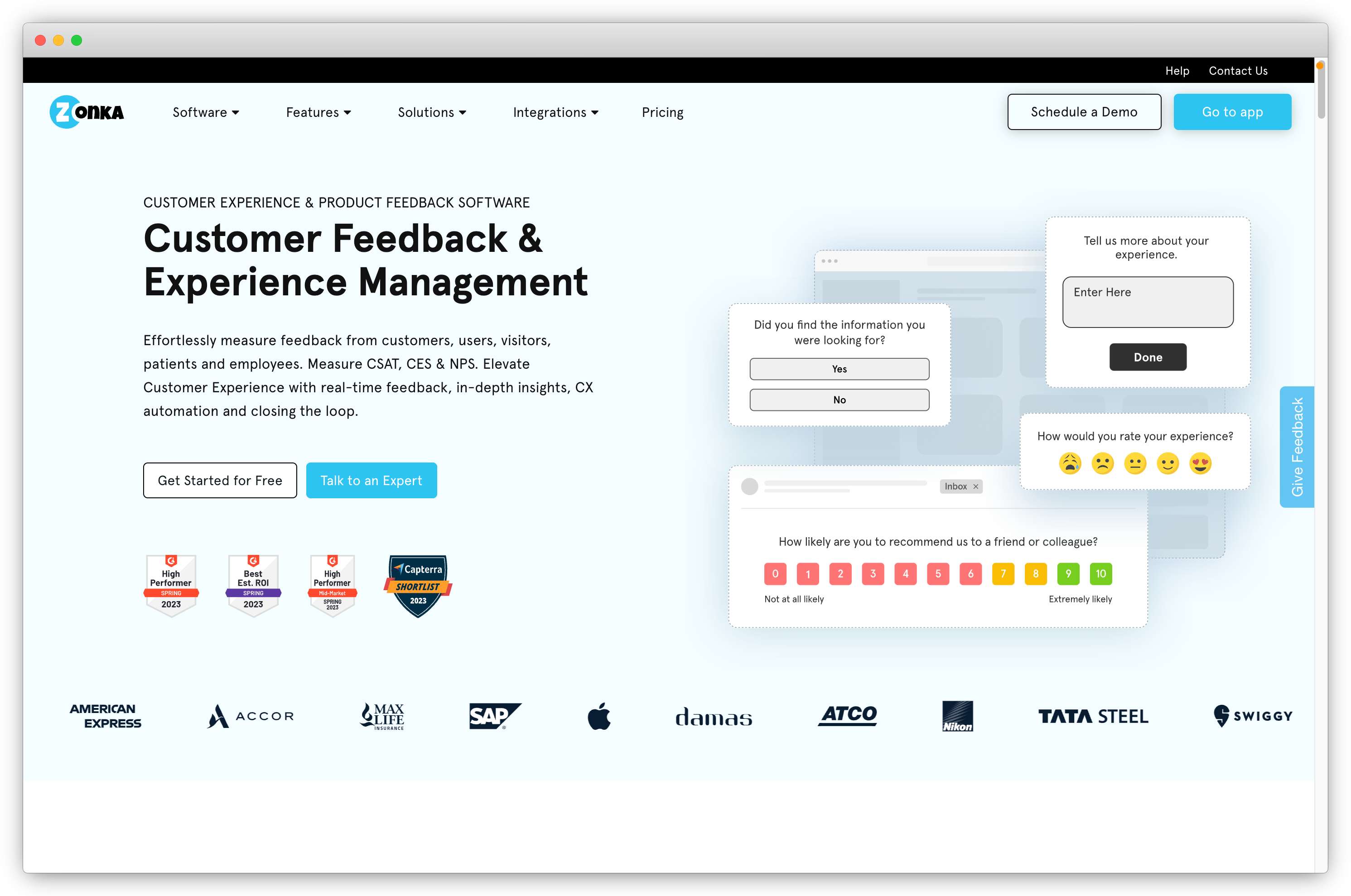 Zonka Feedback is a powerful, AI-driven customer feedback platform designed for businesses that don’t just want to collect feedback—they want to act on it and drive measurable improvements. Whether you’re a startup or a large enterprise, Zonka Feedback helps you gather insights across multiple channels, analyze trends, and close the feedback loop—all from a single platform.
Zonka Feedback is a powerful, AI-driven customer feedback platform designed for businesses that don’t just want to collect feedback—they want to act on it and drive measurable improvements. Whether you’re a startup or a large enterprise, Zonka Feedback helps you gather insights across multiple channels, analyze trends, and close the feedback loop—all from a single platform.
Unlike traditional survey tools, Zonka Feedback is built for real action. It goes beyond simple data collection by offering AI-powered sentiment analysis, real-time feedback tracking, and automation that ensures every response leads to meaningful outcomes. Whether you’re measuring NPS, CSAT, CES, or capturing in-depth qualitative insights, Zonka Feedback provides the tools to understand customer sentiment and act on it instantly.
Key Features
- Omnichannel Feedback Collection – Collect feedback via email, SMS, WhatsApp, website pop-ups, kiosks, in-app surveys, and offline surveys.
- AI-Powered Insights – Get real-time sentiment analysis, text analytics, and automatic categorization to uncover trends at scale.
- Intelligent Survey Builder – Build highly customizable surveys with 100+ templates and 30+ question types, including rating scales, MCQs, and open-ended questions.
- Real-Time Reports & Dashboards – Monitor feedback instantly with trend analysis, drill-down reports, and response heatmaps.
- Automated Workflows & Alerts – Assign tasks, trigger follow-ups, and notify the right teams automatically to ensure prompt action.
- Website Feedback Widgets – Collect insights using popup surveys, embedded feedback buttons, and exit-intent surveys.
- Multilingual Surveys – Expand reach with surveys in multiple languages to cater to a global audience.
- Seamless Integrations – Connect with CRM, helpdesk, and marketing tools like Salesforce, HubSpot, and Zendesk.
- Enterprise-Grade Security – Ensure compliance with ISO 27001:2022 certification and robust data security measure
While most tools focus on collecting feedback, Zonka Feedback ensures you act on it effectively.
- Smart Targeting & Segmentation – Deliver the right surveys to the right customers based on behavior, demographics, and past interactions for more relevant insights.
- Survey Throttling – Prevent survey fatigue by limiting how often customers receive surveys, ensuring higher response rates without overwhelming them.
- Case Management & Task Automation – Convert feedback into action by automatically creating tasks, assigning them to teams, and tracking resolution progress.
- Device Tracking & Multi-Location Insights – Monitor responses across kiosks, tablets, and multiple locations to track customer experience in real-world settings.
- Dedicated Support & Custom Integrations – Get expert assistance for seamless integrations, onboarding, and tailored feedback workflows.
Pros
- Versatile survey distribution channels like SMS, email, website, offline, kiosk, and more
- Easy-to-use intuitive interface
- Real-time data collection with immediate feedback and response tracking
- AI-powered features like text analytics, sentiment analysis and workflow automation
- Wide range of survey templates with question types
- Data security with ISO 27001:2022 certification
Cons
The feedback tool may not integrate with every software out there but the team can build custom integrations to fit your specific needs
Rating
4.8
2. Chisel
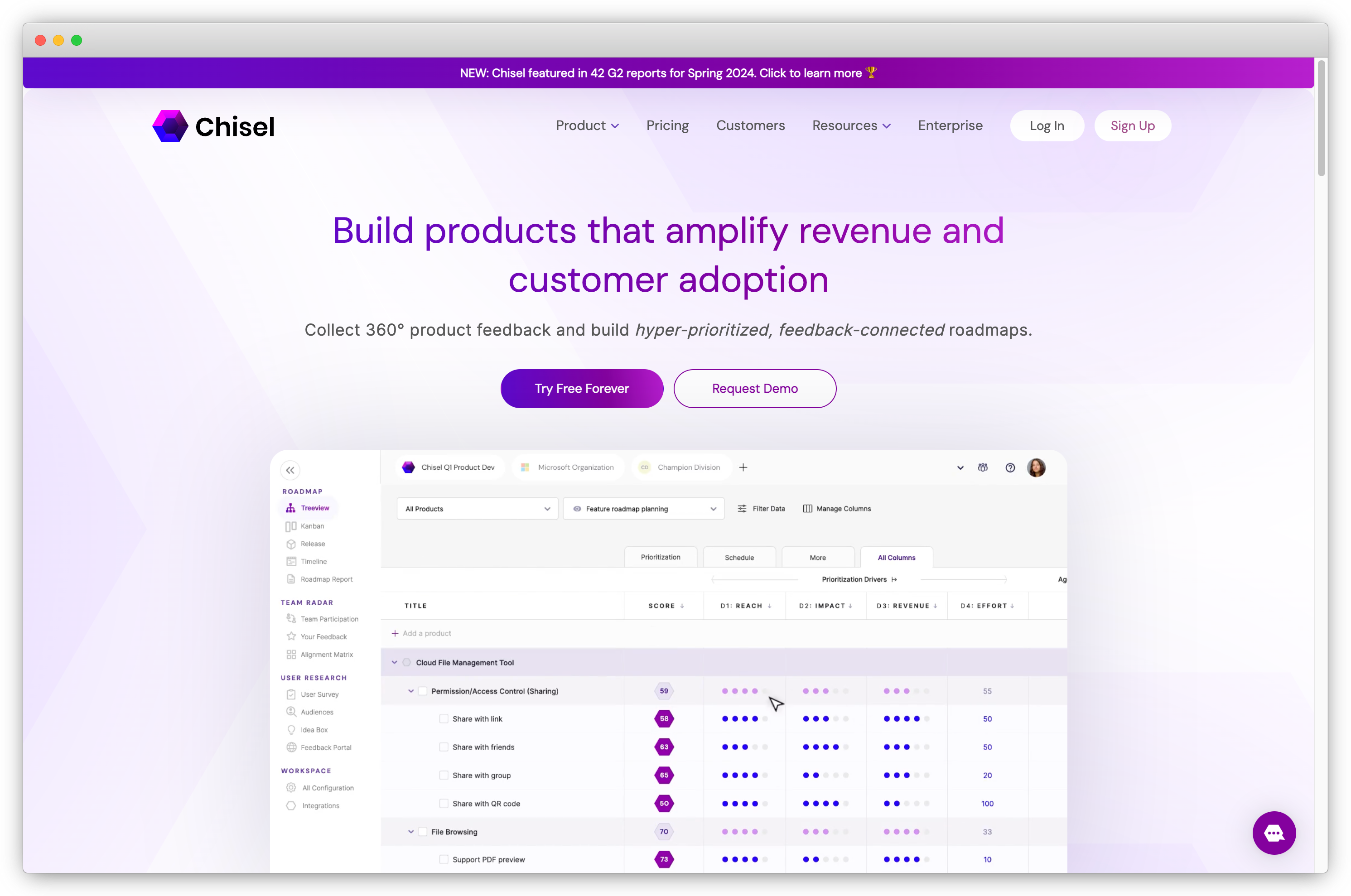
Chisel is one of the most innovative customer feedback software today. Being the top-notch product management tool, Chisel knows that customer feedback analysis is the only path to your success.
In addition to providing an exclusive Product Feedback Pillar, Chisel has also incorporated the transformative capabilities of artificial intelligence, aiming to redefine how companies engage with and comprehend the insights from their customers.
Key Features
- Idea Box, is a central repository to organize all user ideas in one place.
- Auto-labeling with AI for streamlined ticket organization
- Feedback Portal to save and manage customer feedback with just a single link.
- Build surveys from scratch or use templates
- Tailor audience panels as needed
- Roadmap prioritization based on user feedback
Pros
- AI-powered organization through auto-labeling
- Centralized user feedback through Idea Box
- Translates feedback into actionable roadmaps by connecting feedback to specific features
Cons
- Occasional lag times within the platform
- It lacks features for specific use cases
Rating
4.9/5
Free Option
Chisel offers a free forever version. You can also enjoy a ‘Premium’ trial that lasts for 15 days and has no subscription charges.
3. TypeForm
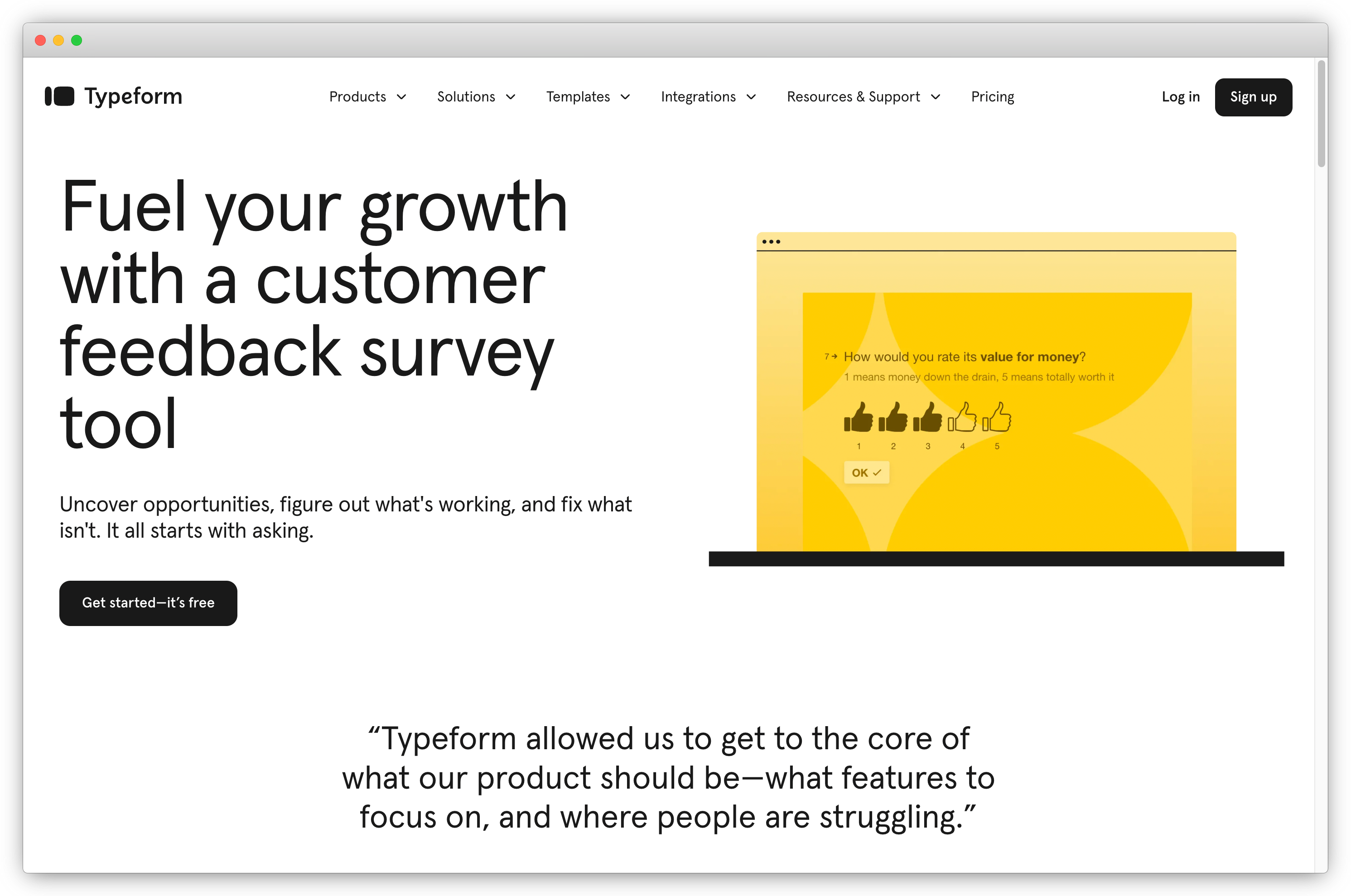
TypeForm has to be one of the most interactive and best customer feedback tools if you are looking for surveys that engage your target audience. You can embed images, videos, icons, etc, in your survey forms. Moreover, you can create unique survey flows and tones in order to capture the most relevant customer feedback.
TypeForm also allows you to accept payment through its free customer feedback app. You can also schedule your surveys if you wish to clearly define a process.
Key Features
Here are the main features offered by TypeForm:
- Unlimited surveys with 10 questions and 10 responses per month
- Skip logic and hidden fields
- Templates
- Downloadable survey data
- Integration with business tools like Zapier, Slack, Mailchimp, HubSpot, etc.
Pros
-
Visually appealing surveys
-
Advanced features like survey logic and AI integration
-
Seamless integration with other tools
Cons
-
Limited customization for branding needs
-
Fewer options for highly structured questionnaires
Rating
4.7
Free Option
Lifetime Free Account Available
4. forms.app
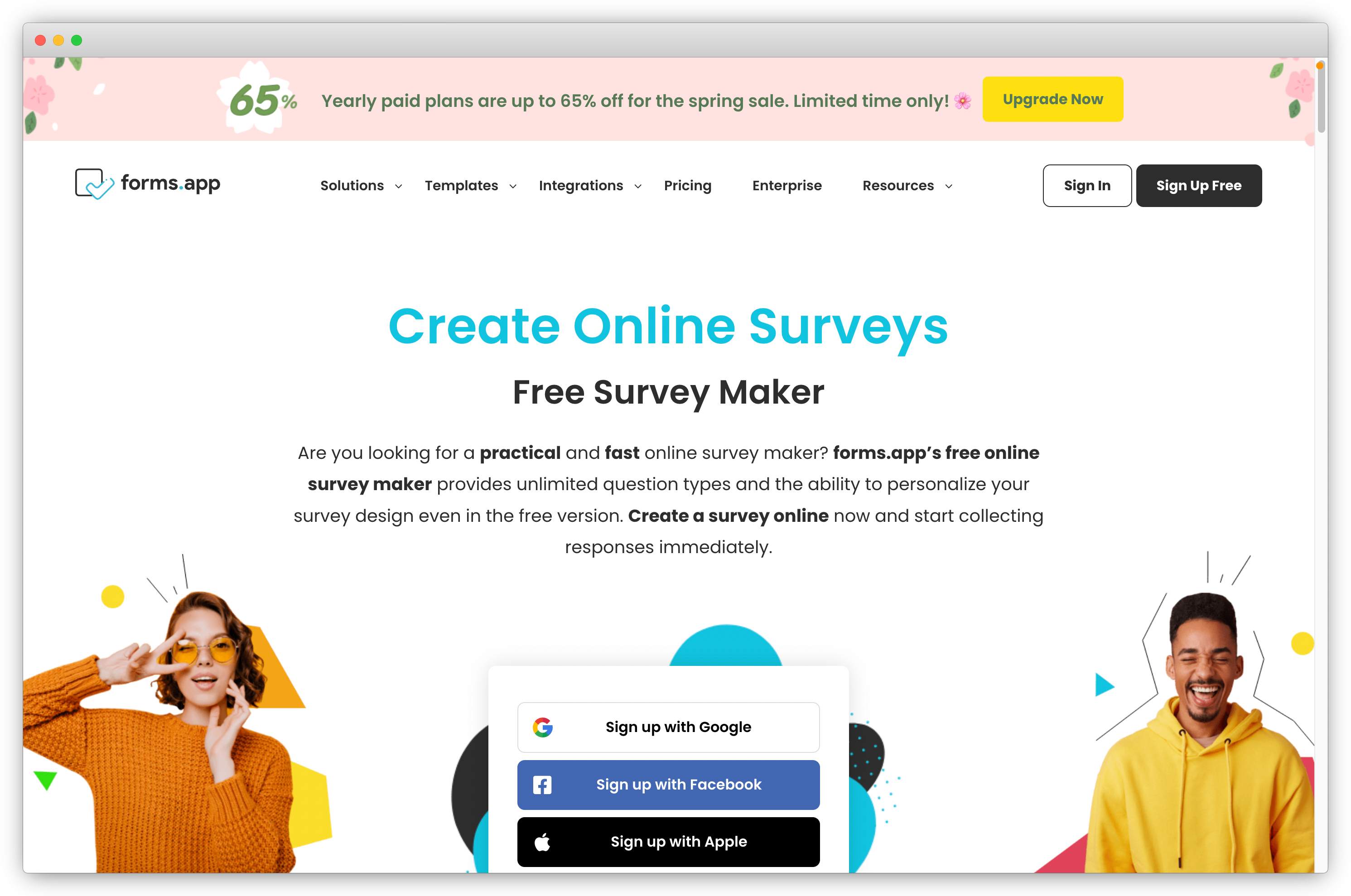
forms.app is one of the easy-to-use customer feedback tools that help you to create surveys, forms, quizzes, and questionnaires quickly, thanks to its pre-made templates and AI form generator.
It offers a variety of free features, including signature collection, payment acceptance, conditional questions, quiz creation with auto calculations, workflow automation, and advanced customization options.
Key Features
Here are the main features offered by forms.app:
- AI form generator
- +500 third-party integrations
- Various customization options
- Advanced data analytics and reports
- Accessible from everywhere thanks to its mobile application
Pros
- User-friendly interface
- Customizable forms
- Responsive design
- Integrations with popular platforms
Cons
- Limited features in free version
- Basic analytics
- Less advanced customization options
Rating
4.5
Free Option
Free forever plan available
5. QuestionPro
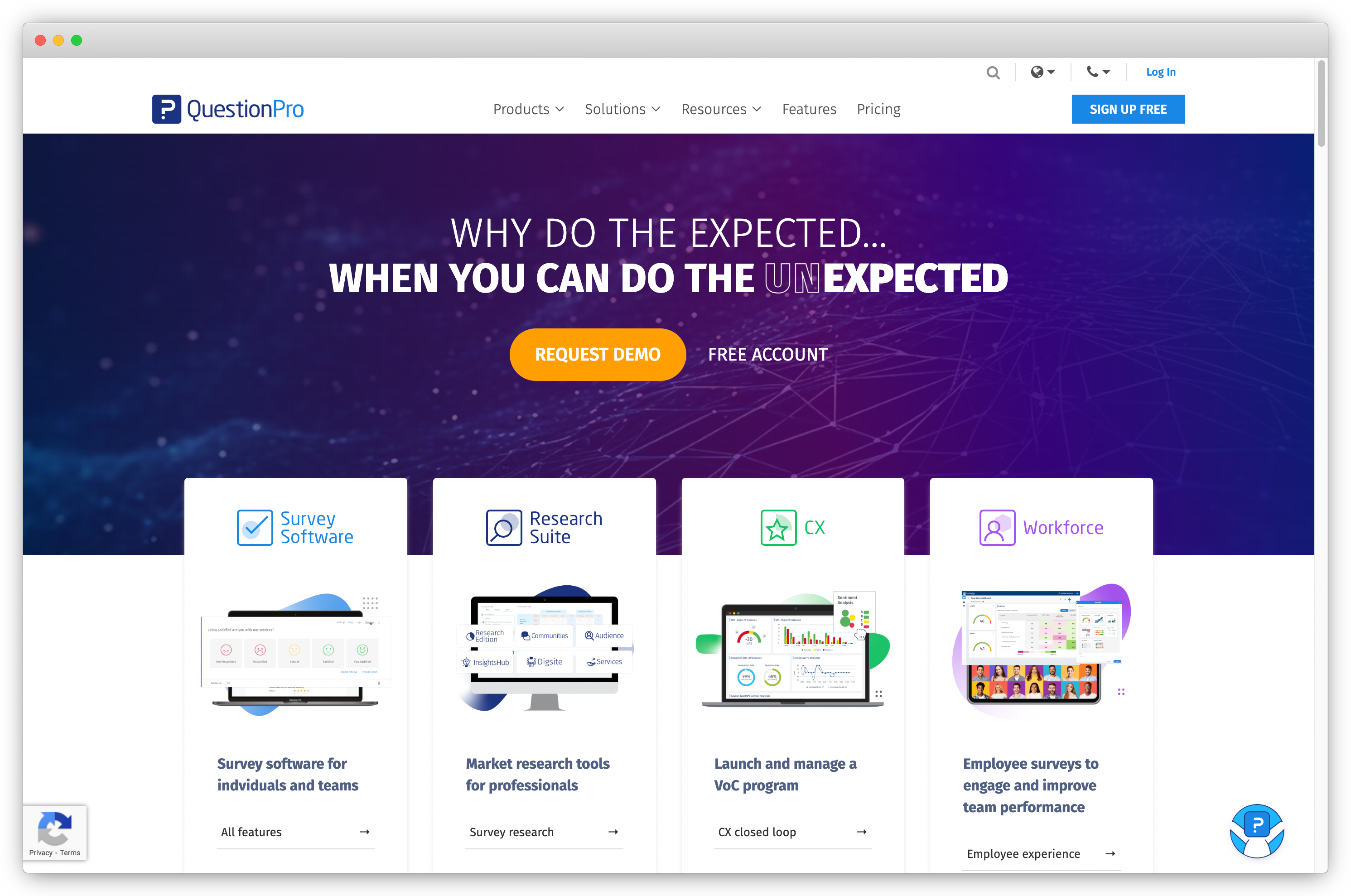
QuestionPro is a community feedback tool that manages all kinds of feedback through a centralized customer feedback platform. You can collect the most accurate customer feedback data – both qualitative and quantitative – with the help of its branching feature.
You can also customize your surveys with your brand theme to improve brand recall.
Key Features
Here are the primary features you can enjoy with the QuestionPro free customer feedback tool:
- Unlimited free surveys with up to 300 responses per survey
- Access to 1 member
- 30+ question types
- Customized surveys for branding
- Skip logic
- Integration with Google Sheets
- Export feedback to CSV and XLS
Pros
- Extensive design customization options, including accessible themes
- Comprehensive analytics for in-depth insights
Cons
- Experience delays or slow loading times when switching between features or applying filters to data
- May not be cost-effective for smaller organizations
Rating
4.7
Free Option
Free Customer Feedback Platform Version Available
6. SoGoSurvey
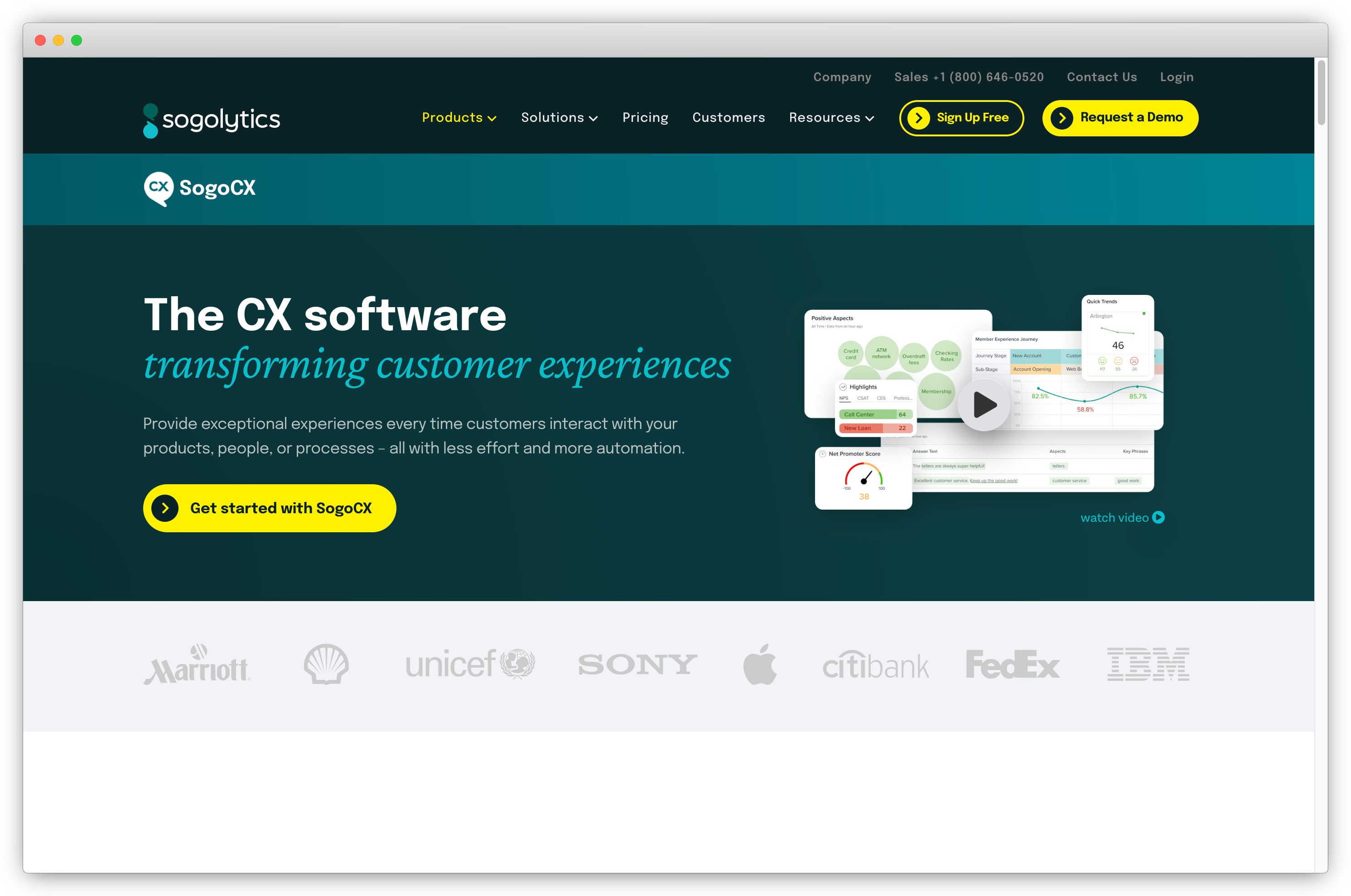
SoGoSurvey is among the top free customer feedback tools ideal for businesses of all sizes. So, if you’re using SoGoSurvey for your small business, you can continue using it even after you expand. The tool is known for its short learning curve.
However, you cannot access integration benefits with the free plan.
Key Features
Here are the main features offered by SoGoSurvey:
- Template bank with customizable reports
- Social media sharing
- One-click reports
- Built-in data analytics (Predictive Analytics)
- SSL encryption
Pros
- User-friendly interface to create and deploy surveys
- Conditional logic to personalize survey experience
- Multilingual surveys to reach a wider audience
Cons
Limited advanced data analysis functionalitiesRating
4.7/5
Free Option
Lifetime Free Plan Available with this customer feedback tool
7. Qualaroo (now Proprofs)
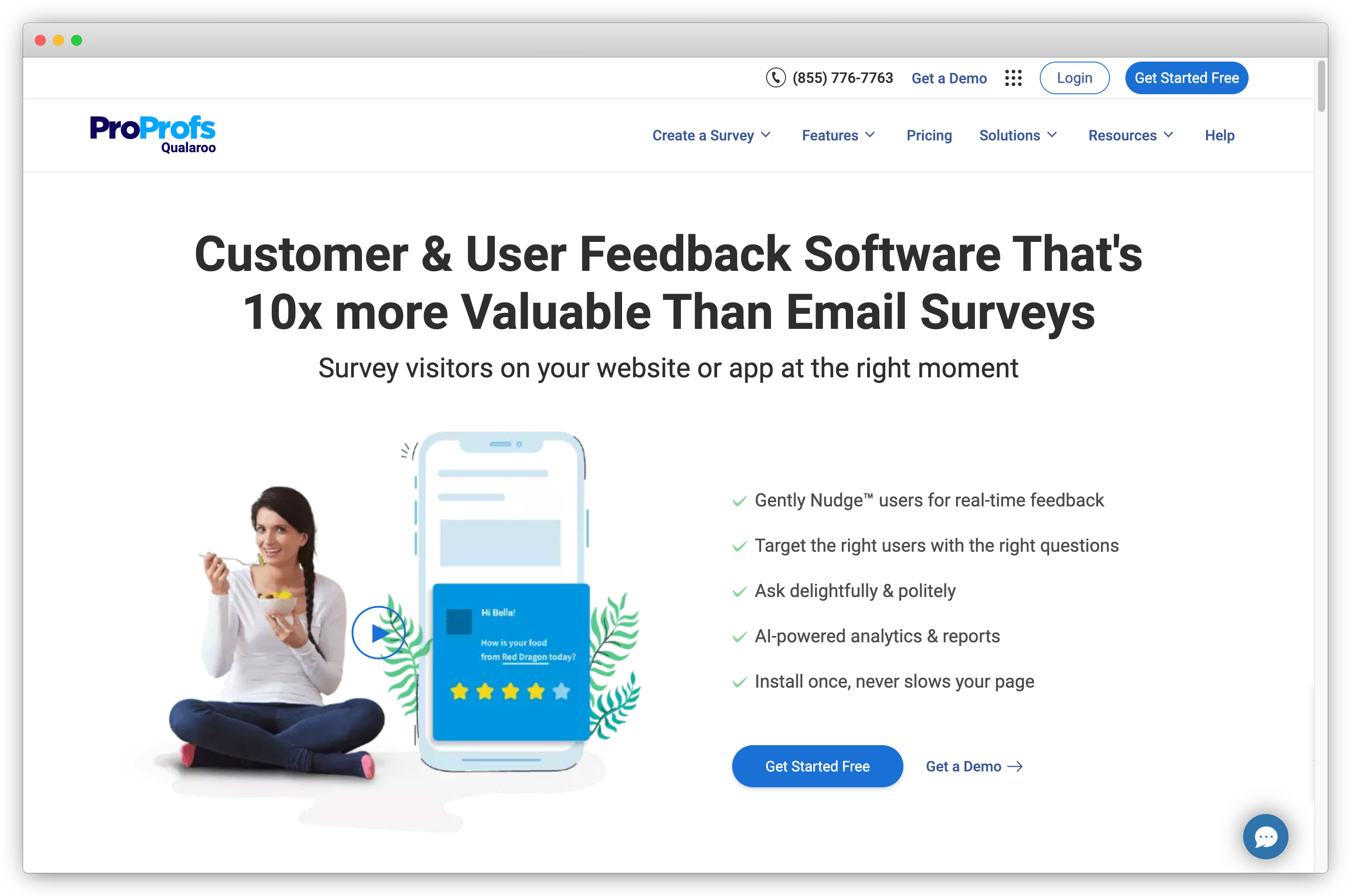
Qualaroo is a powerful online survey tool that helps you collect feedback from your target audience. It is designed to make survey creation easy and supports multi-channel targeting.
You can create hidden survey Nudges™ for your website, mobile app, Android Survey App and SaaS product to collect in-the-moment feedback from the target audience. You can also launch surveys in your prototypes to collect feedback during development.
Qualaroo also has a powerful AI-based sentiment analysis engine that analyzes the customer feedback data in minutes to share the sentiments behind the feedback.
It can help save time and allow you to focus on closing the feedback loop rather than picking valuable insights manually.
Key Features
- Visual builder to design various online survey types.
- Pre-built survey templates and 12+ question types to create surveys in minutes.
- Skip and branching logic
- Survey customization, rebranding, and white-labeling.
- Support for 70+ languages.
- Built-in advanced targeting options to trigger surveys at a specific time, under particular conditions.
- Visual NPS dashboard and automatic NPS calculation
- Advanced reporting section.
- Integration with tools like Slack, Hubspot, etc.
Pros
- Multiple feedback channels including pop-up surveys, NPS surveys, on-site polls, etc.
- Advanced targeting based on behavior, demographics, etc.
- AI-Powered sentiment analysis
- Advanced reporting and analytics
Cons
- The click-to-edit interface can be limiting for rearranging question order or complex layouts
- Might not be cost-effective for smaller organizations
Rating
4.4
Free Version
Free version and free trial is available for 15 days with this customer feedback tool
8. SurveyMonkey
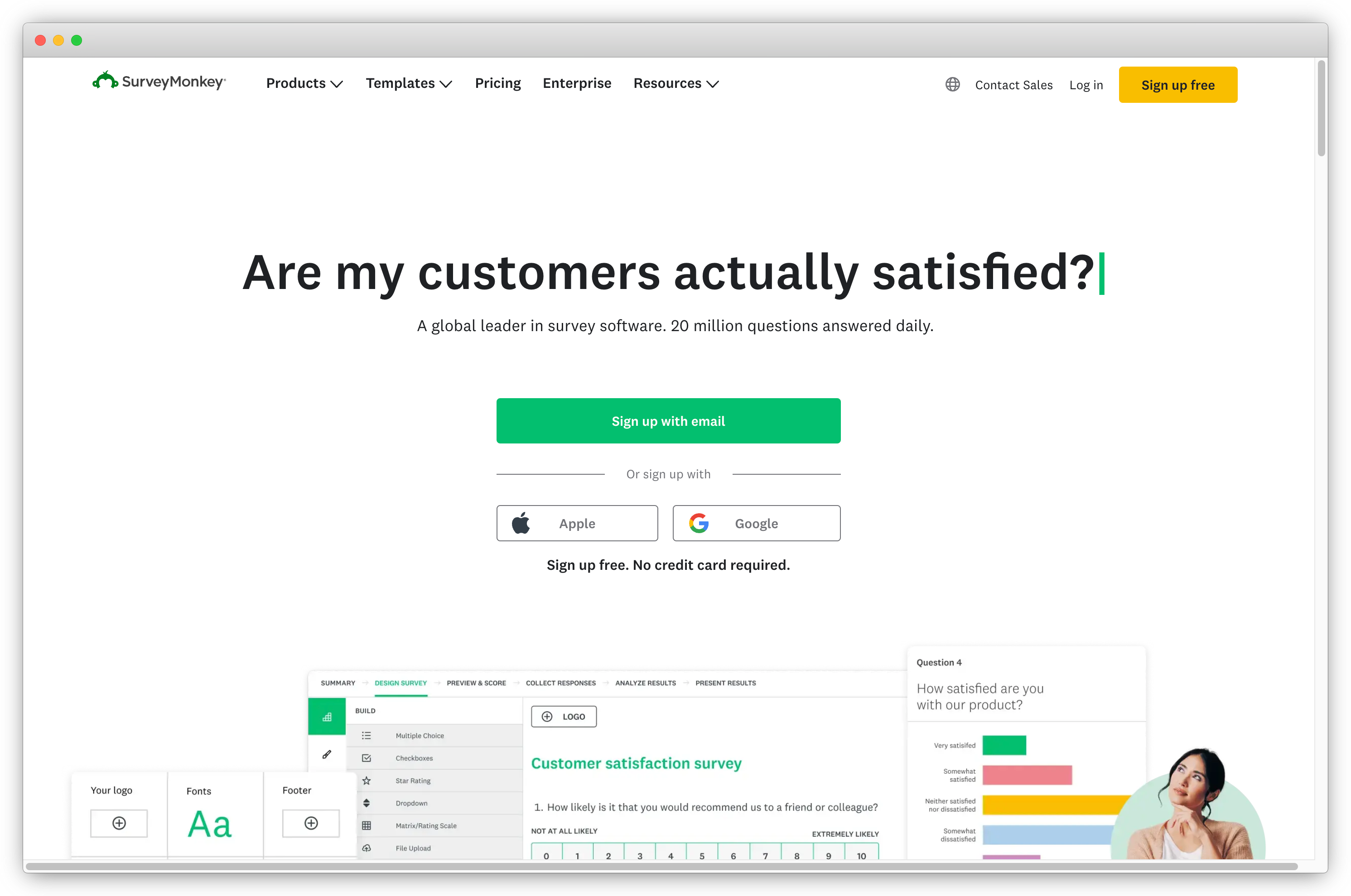 SurveyMonkey is one of the best customer feedback tools out there that doubles as the voice of customer survey tool as well. You can use SurveyMonkey's free customer feedback platform with some limited features. However, the tool is excellent when it comes to data management.
SurveyMonkey is one of the best customer feedback tools out there that doubles as the voice of customer survey tool as well. You can use SurveyMonkey's free customer feedback platform with some limited features. However, the tool is excellent when it comes to data management.
For example, you can access all your survey data on a single dashboard and analyze it with the help of graphs and charts.
Moreover, it is one of the easiest free customer feedback tools since it allows creating surveys without any coding required.
Key Features
Here are some of the primary features offered by SurveyMonkey:
- Up to 3 team members and 10 questions per survey
- 40+ short survey templates
- Real-time notifications
- 1 survey report filter
Pros
- Wide customization option to design surveys that match your brand
-
Variety of survey-sharing options
-
Ability to get responses from outside of your existing audience
Cons
- Lacks visual logic map
- Limitation for personalization for complex surveys
Rating
4.6
Free Version
Lifetime Free Customer Feedback Version Available
9. HubSpot
HubSpot Service Hub is an all-in-one customer service solution with excellent feedback management functionalities. The customer feedback tool allows you to set up CSAT, NPS, and CES surveys through numerous customizable templates, but you also have the option to create your own feedback surveys from scratch.
You can deploy feedback forms via web links and email while you can monitor key metrics, like satisfaction scores, total form views, and responses through an intuitive dashboard.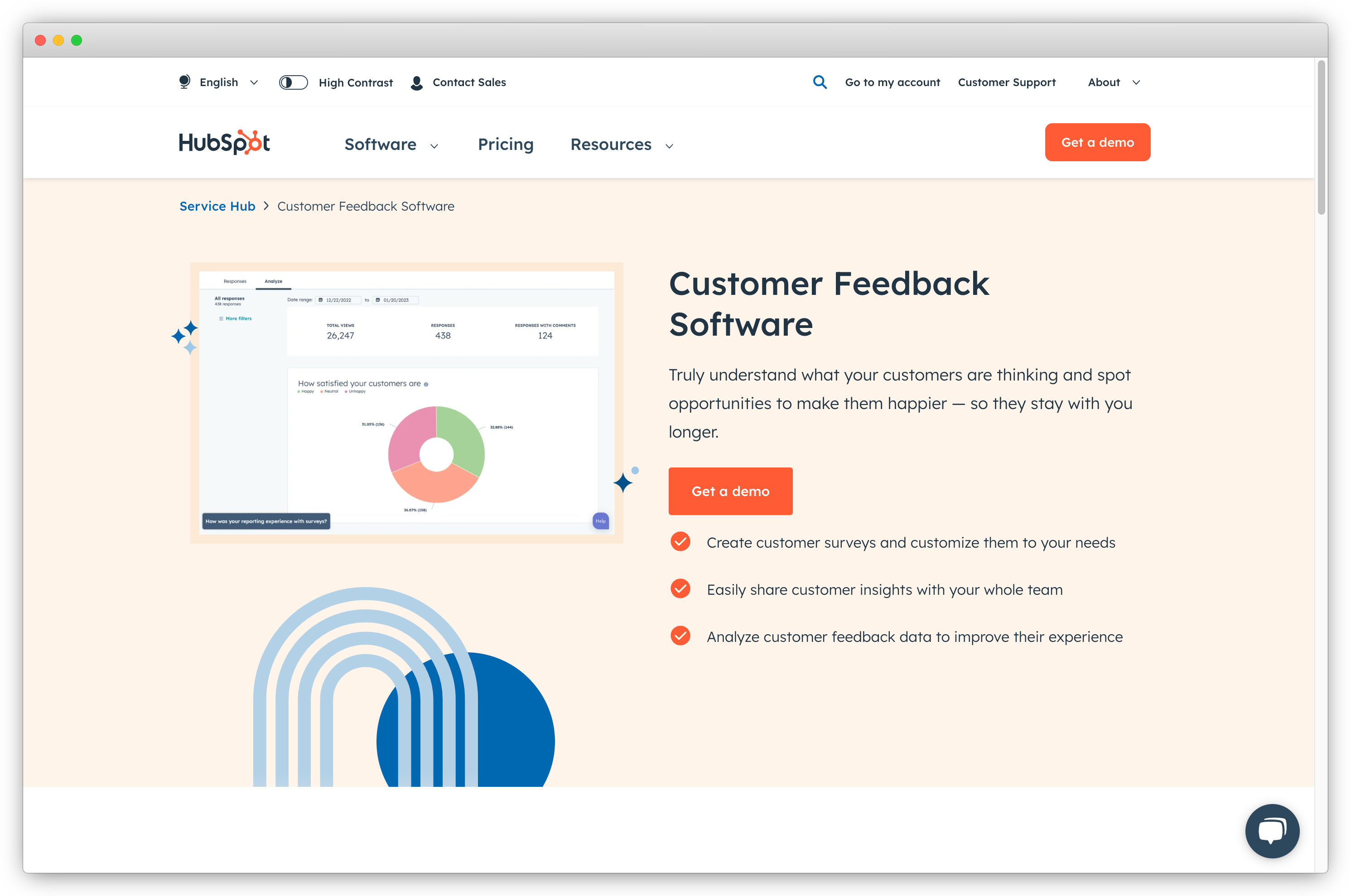
Key Features
Here are some of the primary features offered by HubSpot Service Hub:
- Access to numerous integrations through HubSpot’s App Marketplace
- Access to an ample set of other customer service features
- Monitor survey results in real-time
- Customizable templates
- Automated surveys
Pros
-
You can handle social media customer service through HubSpot’s social media tools
-
Easy-to-digest analytics dashboards
-
Highly intuitive interface
Cons
- Large pricing differences between paid plans make scalability a challenge
Rating
4.4
Free Version
HubSpot Service Hub does not offer a free version
10. Formsite
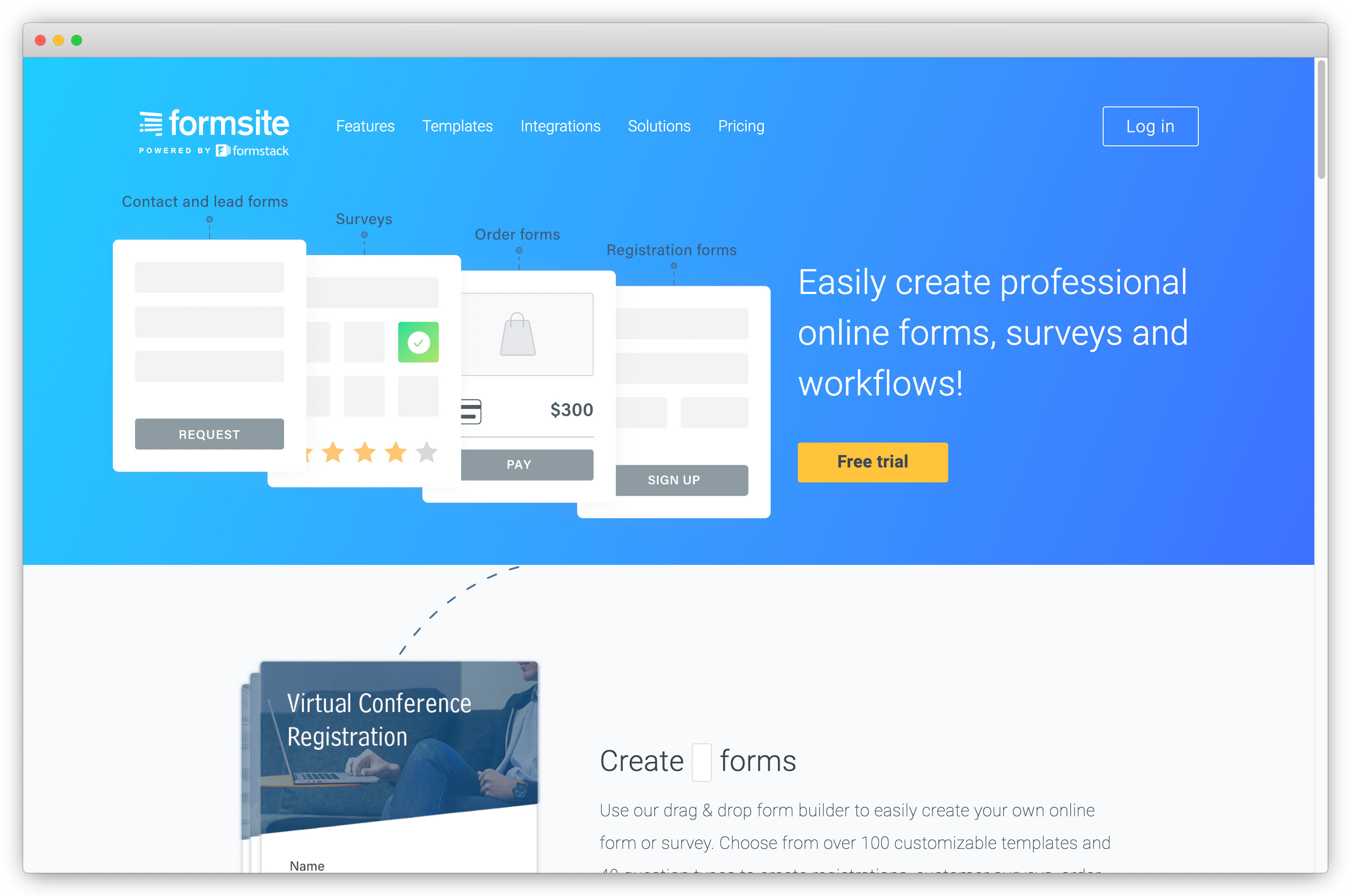
Formsite is a simple and best customer feedback tool for small businesses that allows creating of professional HTML survey forms. However, you can simply drag and drop to create your surveys from scratch or use readymade survey templates. You can also customize your surveys to match your branding theme.
You can share Formsite customer surveys through email or a link, or you can also directly embed customer surveys into your website.
Key Features
Here are the top features offered by Formsite:
- 5 surveys
- 10 responses per survey
- 100+ customizable templates
- Survey branding
- Real-time email notifications or alerts
Pros
- Drag-and-drop interface makes building forms and surveys simple
- Cost-effective solution compared to custom development.
- Secure submissions with SSL/TLS encryption and compliance with HIPAA and GDPR
Cons
- Might not have all features for highly specialized use cases
- Some users report occasional lag times within the platform
Rating
4.5
Free Option
14-Day Free Trial Available with Formsite customer feedback tool
11. Alchemer
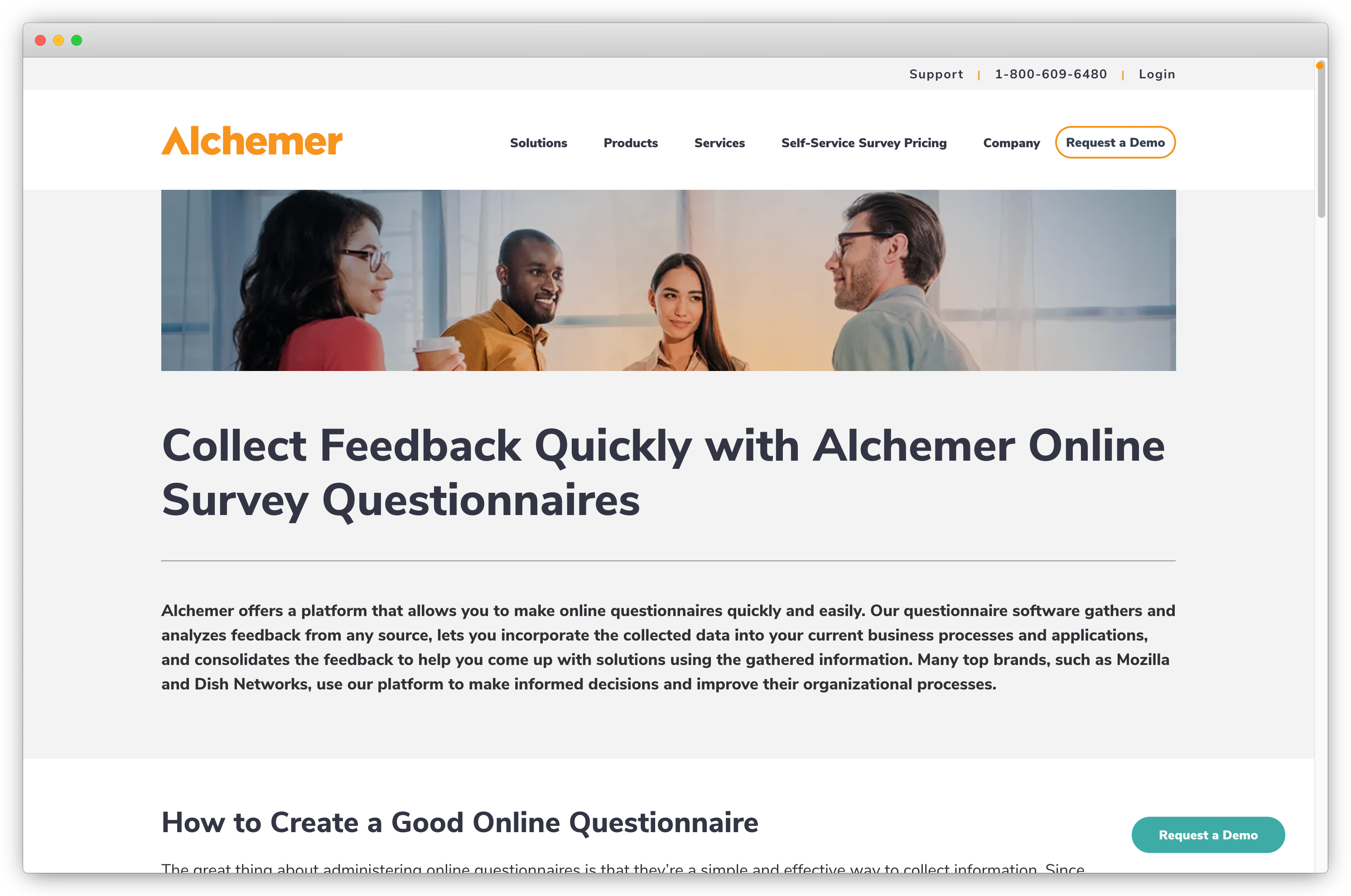
Alchemer is one of the well-established free customer feedback tools that small businesses can use for their voice of customer surveys. There are several free templates available that you can customize to achieve your purpose and create unlimited surveys.
There is, however, a disadvantage of using the free version of Alchemer. You cannot download your old reports and data.
Also, you will be able to only view the recent 12 hours of data.
Key Features
Here are the primary Alchemer features:
- Up to 5 contacts in email surveys
- API - 60 requests per minute
- Survey sharing through links and other platforms
Pros
- Advanced customization options
- Comprehensive survey features
- Robust reporting and analytics
- Excellent customer support
Cons
- Higher pricing tiers
- Some users find the interface overwhelming
- Limited design flexibility
Rating
4.5
Free Option
Lifetime Free Account Available
12. Trustmary

Most feedback tools help teams develop processes internally. But few tools make customer feedback visible to all – including potential new customers. Trustmary is one such customer feedback tool that turns feedback into actionable insights and customer reviews. It helps you not only collect feedback, but also analyze and showcase it. With one automated system, you can keep track of customer satisfaction and use your happy customers as your greatest advocates.
Key Features
- Feedback survey templates (NPS, CSAT, star rating)
- Omnichannel survey distribution (email, link, QR code, website embed, NFC stands, and more)
- Turn feedback into reviews
- Customizable feedback reports
- Showcase feedback and reviews on your website
- Automatic branding for surveys and widgets
Pros
- Optimized surveys for maximum response and review rate
- Easy feedback analysis and tracking of customer satisfaction trends
- Flexible and customizable reports that retrieve the customer feedback data
- Use customer feedback as a marketing tool and build trust
Cons
- Limited number of survey templates
- Still lacks some AI features that other tools have
Rating
4.8
Free Option
Freemium available for unlimited time, including monthly limit for responses and widget views
13. ProProfs Survey Maker
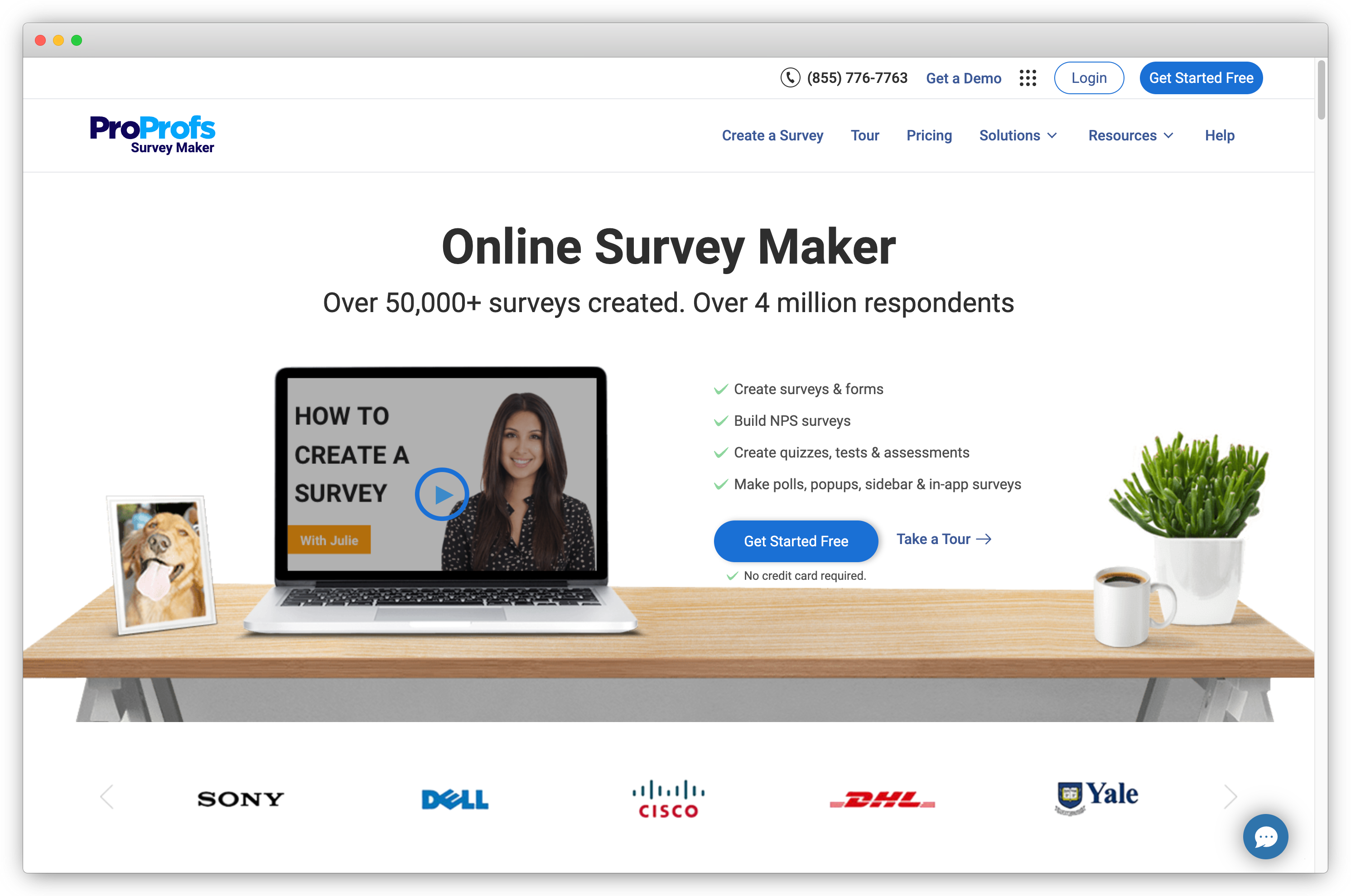
If you want to design engaging surveys to gather real-time customer feedback, then ProProfs Survey Maker is the best option. The free customer feedback tool offers free 100+ ready-to-use survey templates that you can customize using colors, fonts, and your brand logo designs to create a fully personalized experience.
You can share surveys via email survey tools or social media or embed them directly on your website using feedback widgets to collect customer feedback from customer survey tools like this.
Key Features
- Unlimited surveys with up to 10 responses
- Library of ready-to-use questions
- Integrations with WordPress, Salesforce, and Zendesk
- Skip Logic
- 20+ question types
- Advanced reporting with intelligent analytics
Pros
- User-friendly interface with drag-and-drop functionality
- Wide range of question types
- Customizable templates
Cons
- Limited customization compared to high-end tools
- Basic analytics features
Rating
4.8
Free Option
Lifetime Free Version Available
14. Survicate
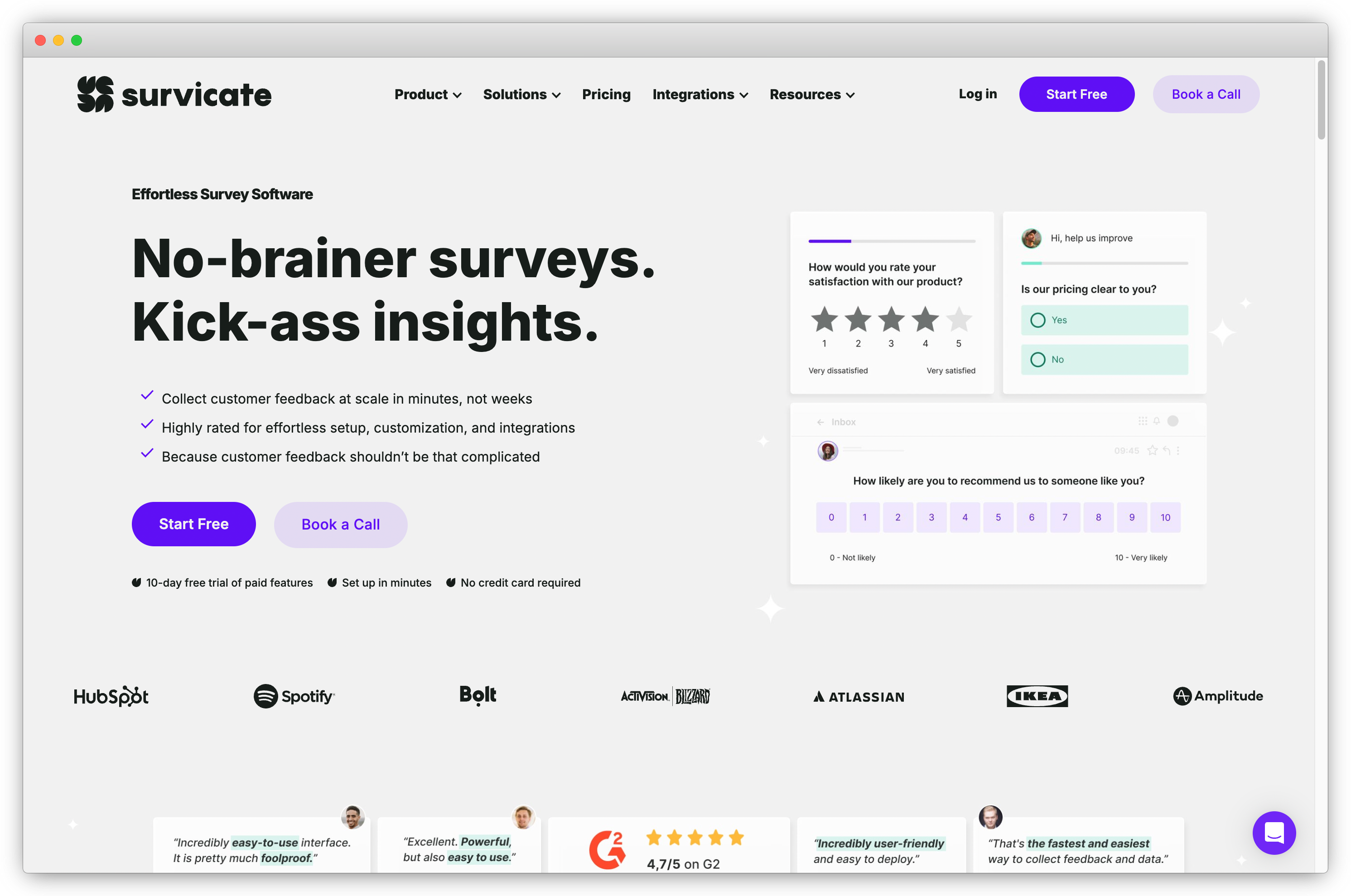
Survicate is your all-in-one customer feedback tool designed to empower businesses with valuable insights into their customers' thoughts and opinions. With this free feedback tool, you can unlock the potential to understand, engage, and improve your customer experience like never before.
This customer feedback platform comes with an intuitive interface, integrations with popular business tools, and affordable pricing plans.
Key Features
- Drag and drop builder to create custom surveys effortlessly
- Multiple ways to collect customer feedback collection through email, on your website, within your app, or via social media
- Advanced targeting and user segmentation options to send targeted surveys at the right moment and to the right audience
- Unobtrusive feedback widgets to engage visitors in real-time
- Set up automated follow-ups, alerts, and notifications
Pros
- Customization options for brand consistency
- Supports surveys in multiple languages
- Collaboration features
Cons
- Occasional lag within the platform's backend
- Fewer integrations compared to competitors
Rating
4.7
Free Option
Offers free version for lifetime with limited features
15. SurveySparrow
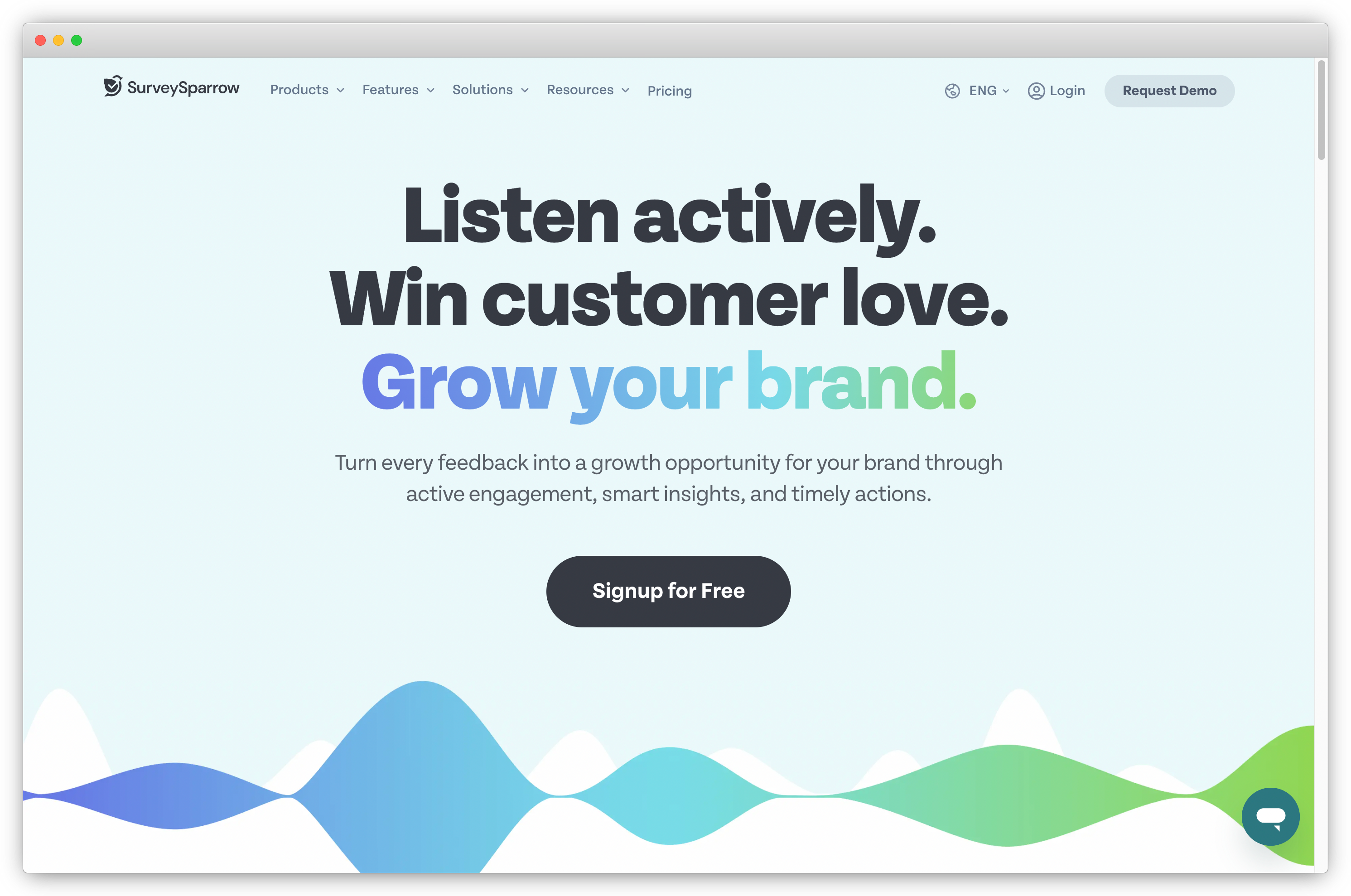
SurveySparrow is a dynamic customer feedback tool that offers unique and interactive survey experiences. With its conversational interface, SurveySparrow allows you to engage your target audience in a more personalized and conversational manner and collect customer feedback.
You can create surveys that feel like natural conversations, making it easier for participants to provide valuable feedback.
You can use this free customer feedback app to take your feedback to the next level by creating engaging and interactive surveys that capture valuable insights. Whether you're looking to collect feedback on your products, services, or overall customer experience, SurveySparrow provides the tools and features to make it happen.
Key Features
- Conversational surveys with chat-like interfaces
- Conditional branching and skip logic
- Customizable survey themes and branding options
- Multilingual surveys to cater to a global audience
- Integration with popular business tools like Slack, Salesforce, and HubSpot
- Real-time analytics and reporting
- Mobile-friendly surveys and offline data collection
Pros
-
Conversational user interface
- Logic jumps to create dynamic surveys
Cons
- Restrictive reporting features
- Smaller range of integrations compared to some competitors
Rating
4.4
Free Option
Offers a free trial with no obligations for 14 days.
Need more than just conversational and chat-like surveys for customer feedback requirements? Check out some of the top SurveySparrow alternatives that you can switch to for a more comprehensive customer feedback tool with advanced analytics.
16. InMoment
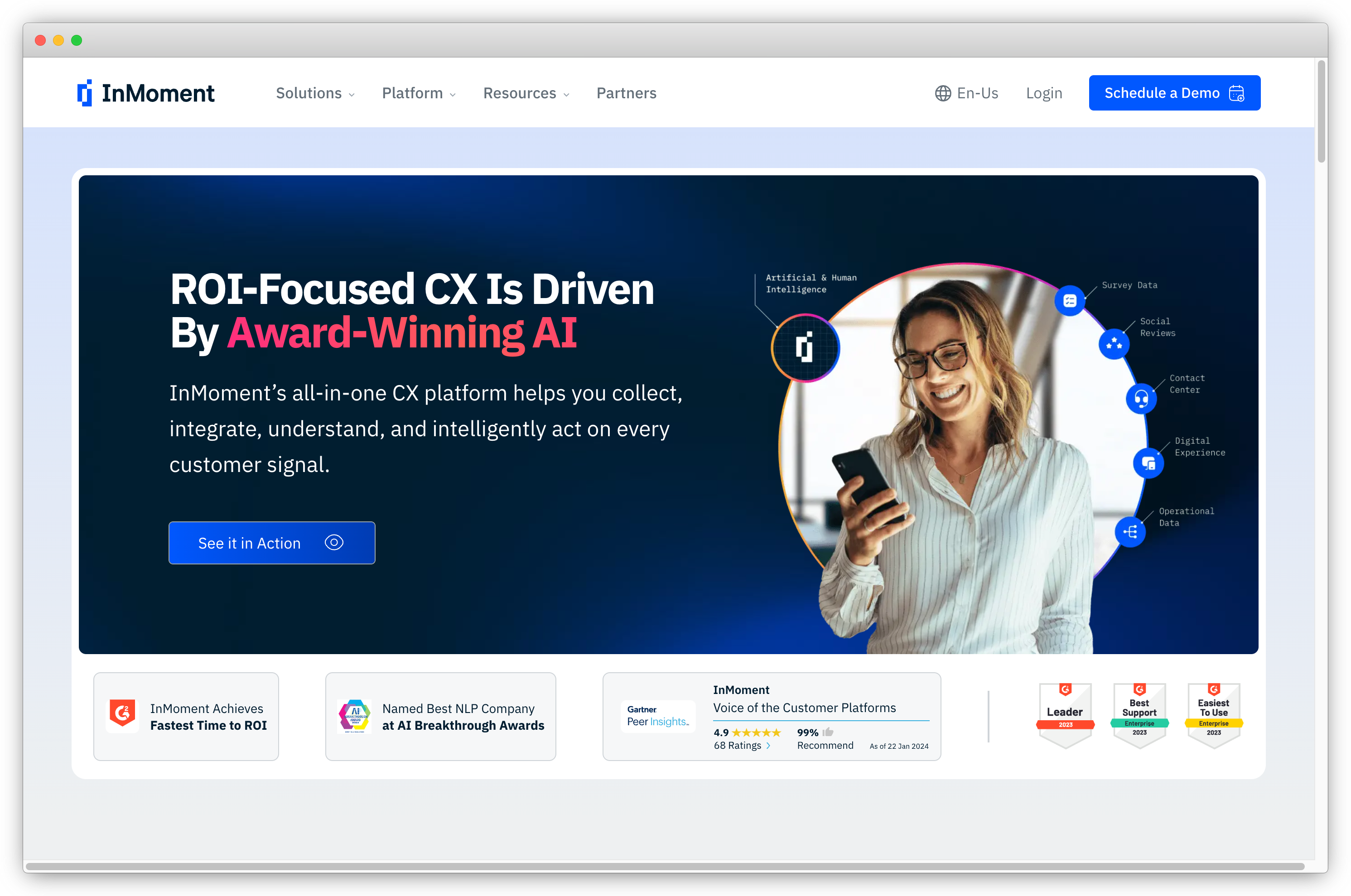
InMoment is a comprehensive customer feedback tool that provides businesses with valuable insights into their customers' experiences. With InMoment, you can gather feedback from various channels and touchpoints, allowing you to gain a holistic view of your customers' thoughts and opinions.
This is one of the best customer feedback platforms out there that lets you gather and analyze customer feedback.
It combines data, technology, and industry expertise to help you gather customer feedback in the moment and take action to improve customer satisfaction.
Key Features
- Capture feedback in real-time
- Gather customer feedback from your customers through surveys, social media, or even voice recordings
- Advanced analytics and reporting capabilities for analyzing customer feedback
- Customizable dashboards and visualizations to track trends, identify areas for improvement, and measure the impact of your customer experience initiatives
- Engage with your customers and close the feedback loop
- Automated follow-ups to personalized responses
- Works great as an enterprise feedback management software
Pros
- Advanced analytics features like sentiment analysis, journey mapping, and text iQ for deep insights
- Enterprise-grade scalability with the ability to handle large volumes of data and complex analysis
- Data data security to industry compliance standards like HIPAA and GDPR
Cons
- High price point compared to simpler feedback tools
- No free plan
- Extensive customization for reports and dashboards might require technical expertise
Rating
4.7
Free Plan
Offers a free trial for microsurveys with its CoreCX.
Looking for a simpler tool with a less complex UI to create your customer feedback surveys? We have compiled a list of the top InMoment alternatives that you can explore as your feedback tools.
17. Qualtrics
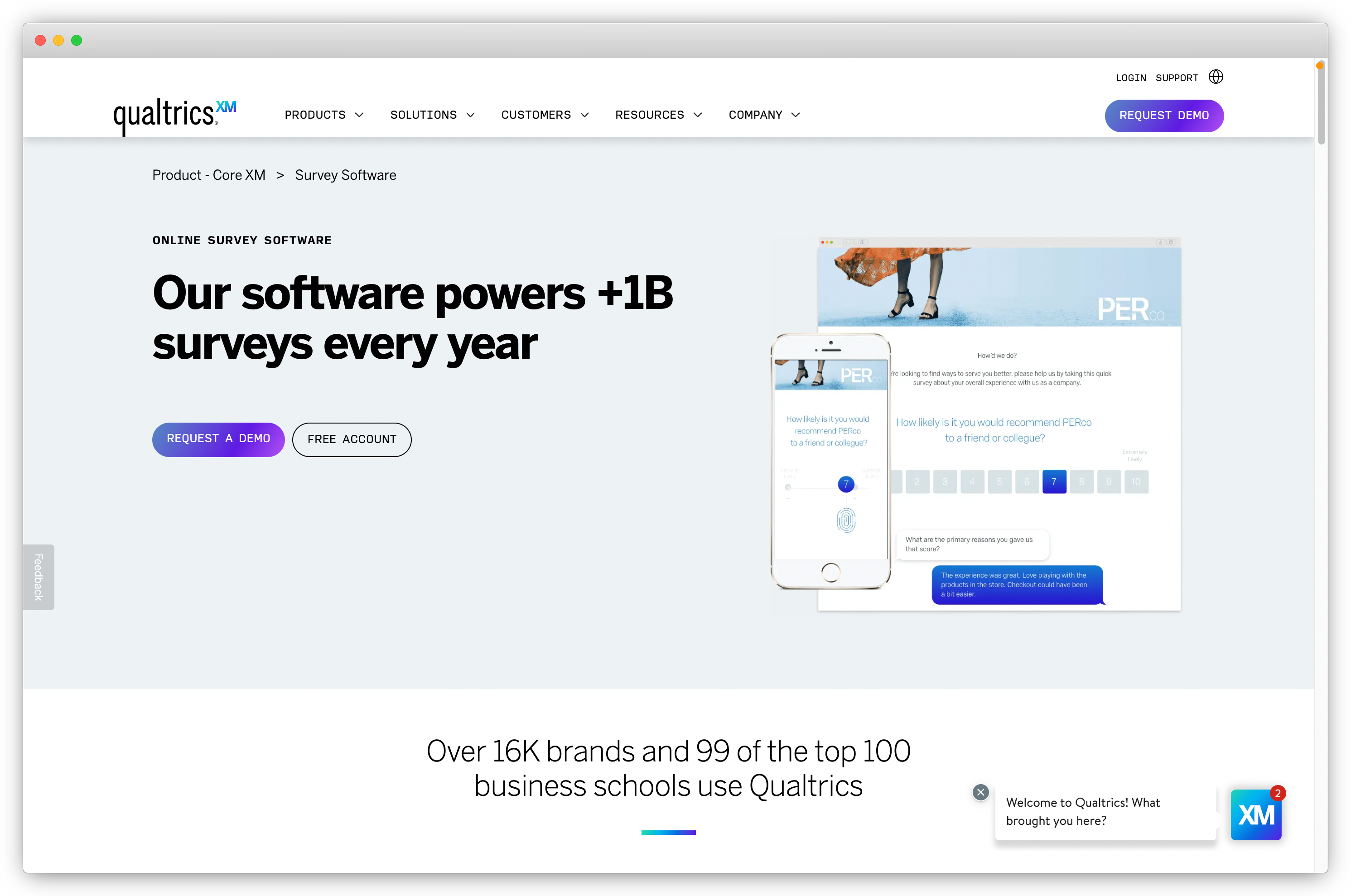
Qualtrics is a great customer feedback tool that offers a comprehensive range of features to help businesses gather valuable insights from their customers. With Qualtrics, you can create customized surveys and collect feedback through various channels, including email, website, and social media.
Key Features
- Advanced analytics capabilities with powerful data analysis tools
- Generate reports and visualizations for a deeper understanding of your customers' thoughts and opinions
- Integrations with popular business tools, such as CRM systems and customer support platforms to streamline your customer feedback management process
- Robust survey customization options, including the ability to create personalized survey themes and branding
- Complete customer experience management platform that lets you collect feedback on 125+ channels
- Automatically deliver recommended actions based on the feedback received
Pros
- Comprehensive suite of features for managing and improving brand experiences
- Role-based access and filtering for personalized experience management
- Offers exceptional data analysis capabilities
- Prioritizes data security with compliance certifications like HIPAA and GDPR
Cons
- Some advanced features may require additional training or expertise to use effectively
- Expensive for smaller businesses
Rating
4.4
Free Plan
There is no pricing information available for Qualtrics.
For several startups and small organizations, Qualtrics might seem too weighed down by features that they don't need. Here are some of the popular Qualtrics alternatives that you can explore as your customer feedback tools.
18. GetFeedback
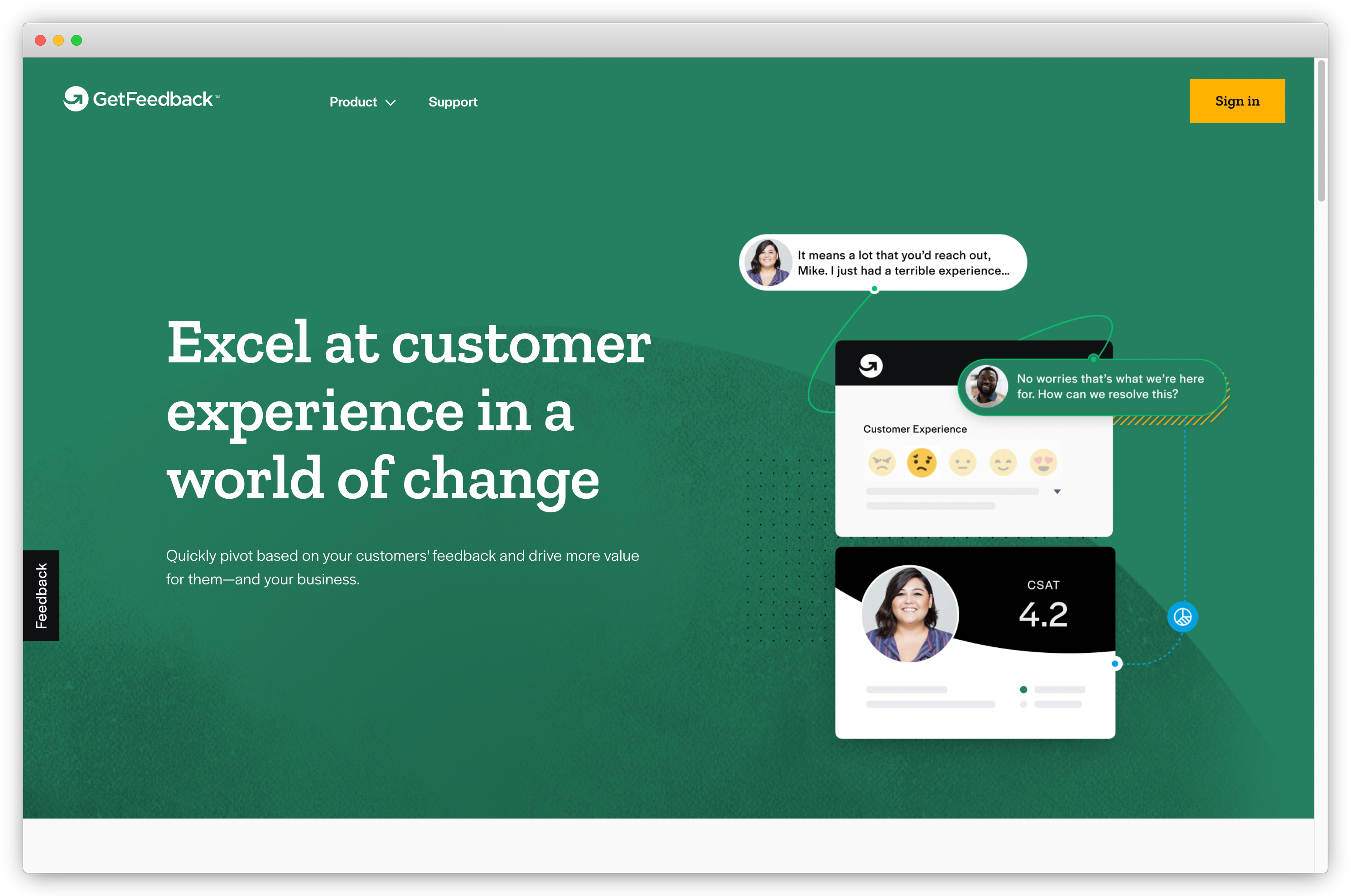
GetFeedback is one of the most comprehensive and best customer feedback tools that offers a range of features to help businesses gather valuable insights from their customers. With this feedback tool, you can easily create interactive and engaging surveys that capture the true sentiment of your customers.
This customer feedback app offers the agility businesses need to enhance their customer experience across every touchpoint in the customer journey through feedback-driven decision-making and close the feedback loop.
Key Features
- Drag-and-drop survey builder with customizable templates
- Real-time feedback collection through email, websites, and mobile apps
- Advanced reporting and analytics to visualize trends and track customer satisfaction
- Seamless integration with popular CRM systems and customer support platforms
- Multi-channel feedback collection for a holistic view of the customer experience
- Automated follow-ups and personalized responses to close the feedback loop
Pros
- Drag-and-drop interface makes building professional-looking surveys straightforward
- Customize surveys with themes, logos, and branching logic to match your needs
- Sentiment analysis to analyze the sentiment of open-ended feedback to understand customer emotions
Cons
Limited customization available
No free plan
Rating
4.5
Free Option
Offers a free trial with no obligations for 14 days.
GetFeedback might look too complex and Salesforce-driven to many. If you are looking for a more intuitive customer feedback platform, here are some of the top GetFeedback alternatives that you can try.
19. Marker.io
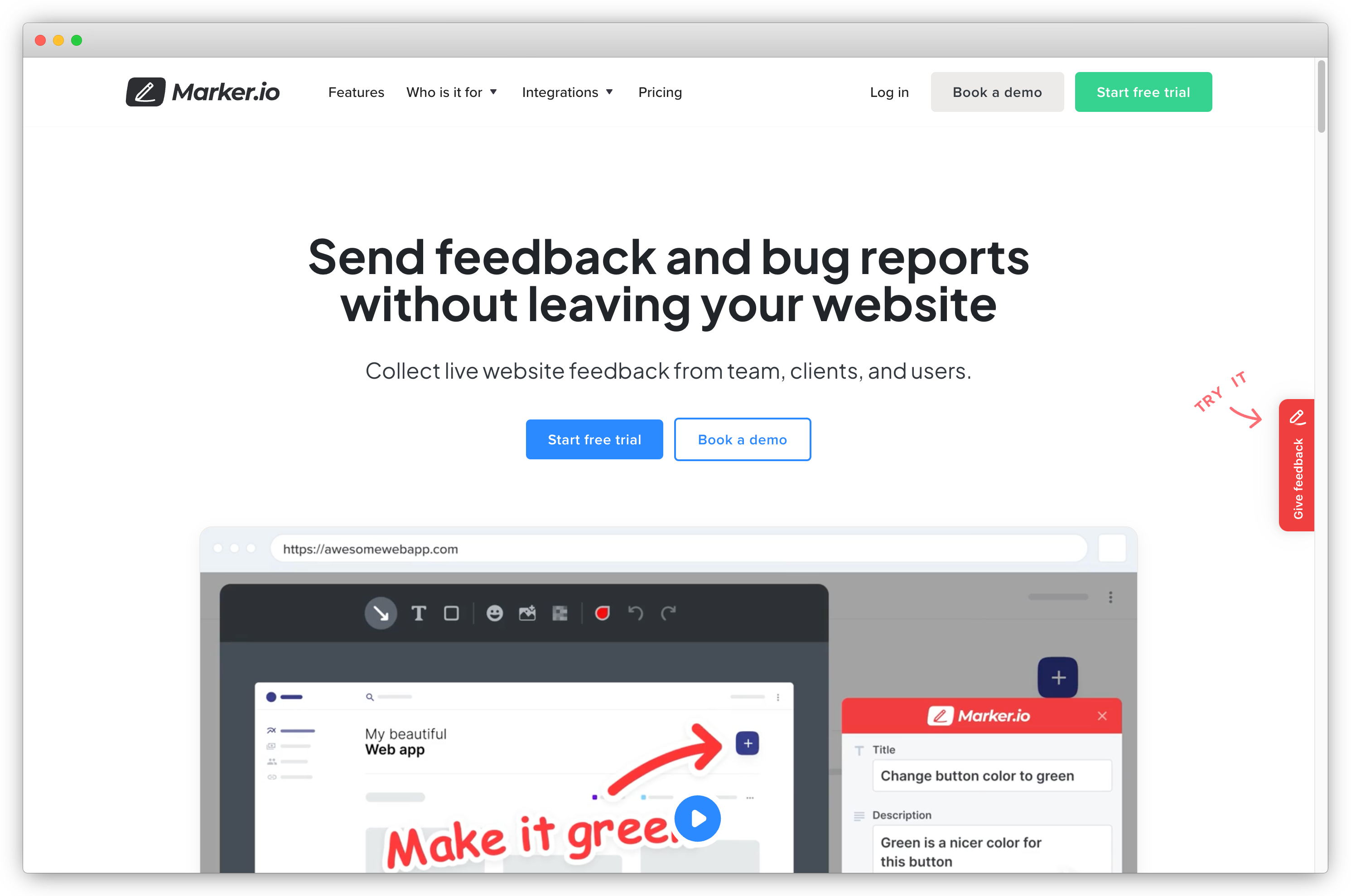
Marker.io is a versatile customer feedback tool designed to streamline the process of visual bug reporting and feedback collection for web development projects. It stands out as a user-friendly platform that empowers teams to effortlessly report and manage issues directly from the website interface for which it also makes its place in best product survey tools.
Key Features
- Visual bug reporting with screenshots
- Easily installable website widget
- Supports a simple and efficient two-way sync with popular apps
- Offers complete customization & white-labeling
Pros
- Easy visual feedback with screenshots and annotate them directly on webpages
- Integrates with popular project management tools like Trello and Jira
Cons
- Focussed more on website bug reporting and feedback
- Free plan not available
Rating
4.9
Free Option
Marker.io offers a 15 days free trial for users to explore its features and capabilities.
20. Jotform
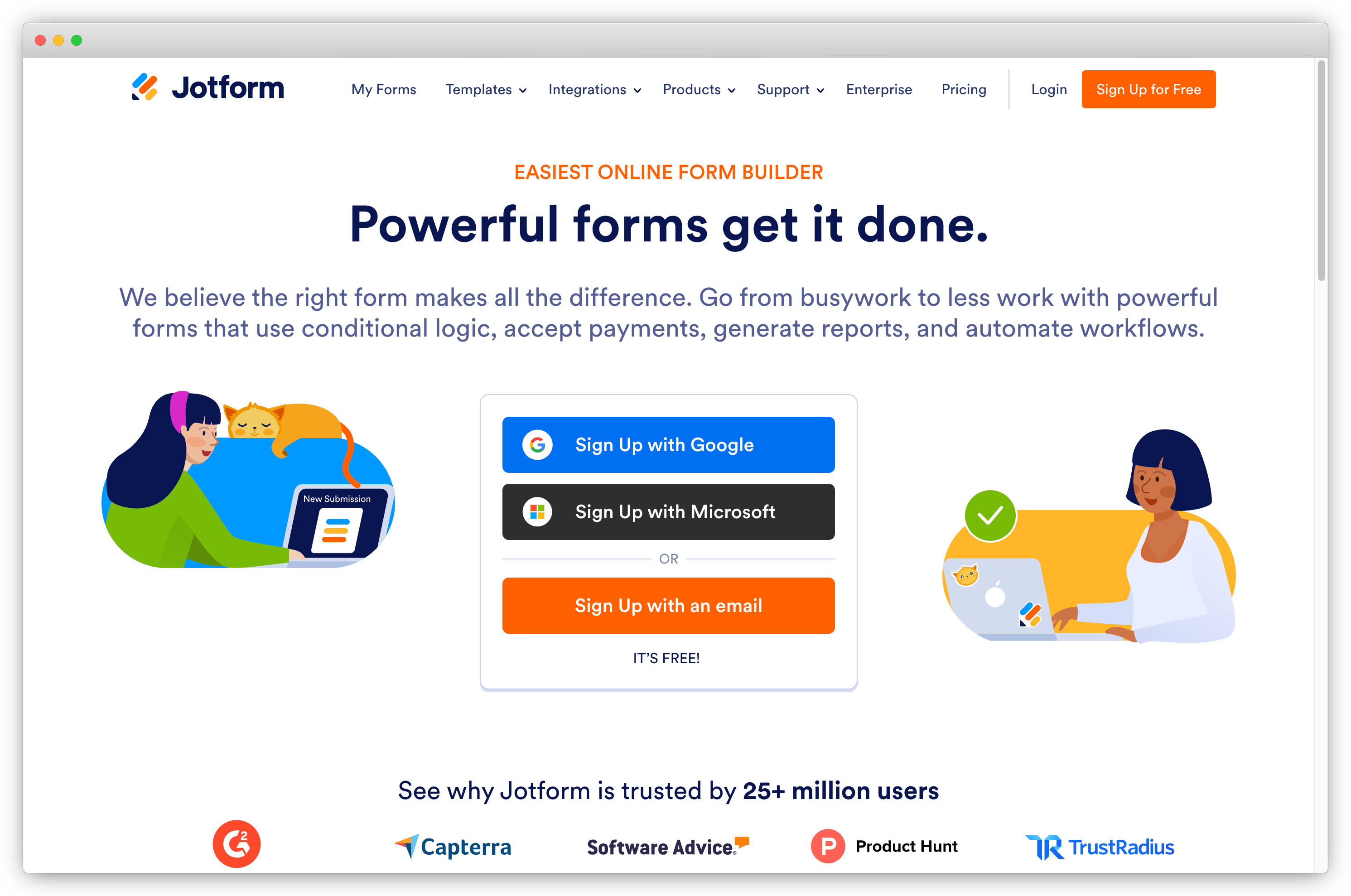
JotForm stands as a robust and versatile customer feedback tool, offering a comprehensive set of features to streamline the process of creating, distributing, and analyzing surveys and forms. Tailored for businesses of all sizes, JotForm empowers users to effortlessly collect valuable insights and feedback from their audience, providing a user-friendly and customizable platform.
Key Features
- Simplifies the survey creation process with its intuitive drag-and-drop form builder for NPS, CES, and CSAT surveys
- Real-time feedback collection through various channels, including emails, websites, and mobile apps
- Advanced reporting and analytics
- Facilitates automated follow-ups and personalized responses
Pros
- Extensive integrations
-
Intuitive and easy-to-use interface
-
Wide range of templates, widgets, and add-ons
Cons
- Limited features on the free plan
- Conditional logic constraints
Rating
4.7
Free Option
This feedback tool offers a free starter pack with a limit of 5 forms and 100 monthly submissions
21. AskNicely
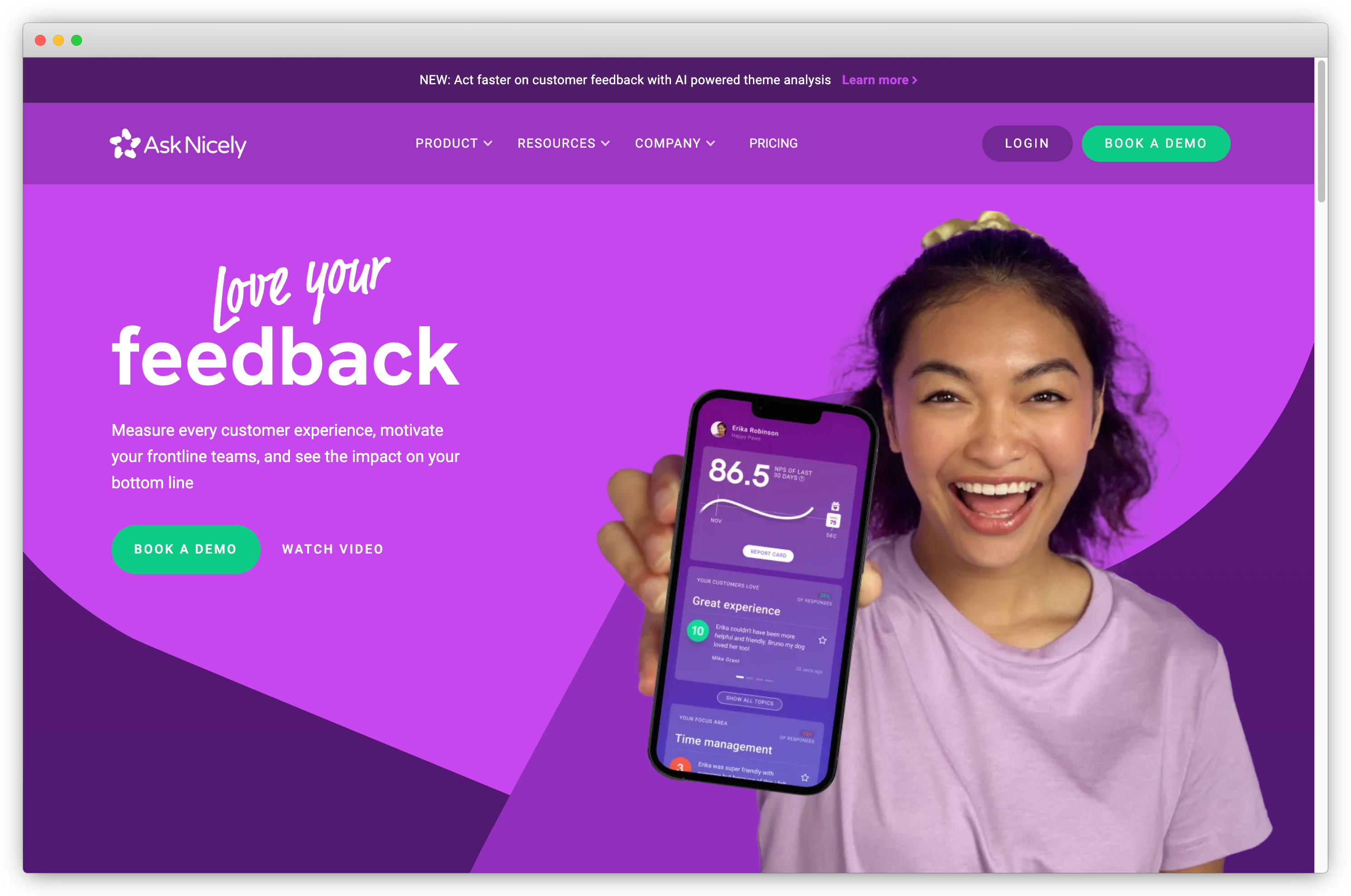
AskNicely is a specialized customer feedback app and CX platform designed to elevate businesses' understanding of customer sentiment and satisfaction through the implementation of Net Promoter Score (NPS) surveys. With a focus on simplicity and effectiveness, this feedback tool empowers organizations to collect, analyze, and act upon customer feedback in a way that fosters lasting customer loyalty.
Key Features
- Specializes in Net Promoter Score (NPS) surveys for measuring customer loyalty
- Automates the process of sending NPS surveys to customers at strategic touchpoints
- Real-time notifications
- Mobile responsive surveys
- Complete customer journey mapping
- Intelligent reporting and analytics
Pros
- Automated workflows to send follow-up emails
- Sentiment analysis to understand feedback sentiment
- Integrates with popular CRM platforms for centralized customer data management
- Offers basic data visualization and reporting tools to track NPS scores over time
Cons
- Primarily focused on NPS surveys, limiting its use for ther types of surveys
- Customization options for surveys and reports limited compared to some survey platforms
Rating
4.7
Free Option
To get pricing estimate from AskNicely, one would need to talk to their sales team
22. Retently
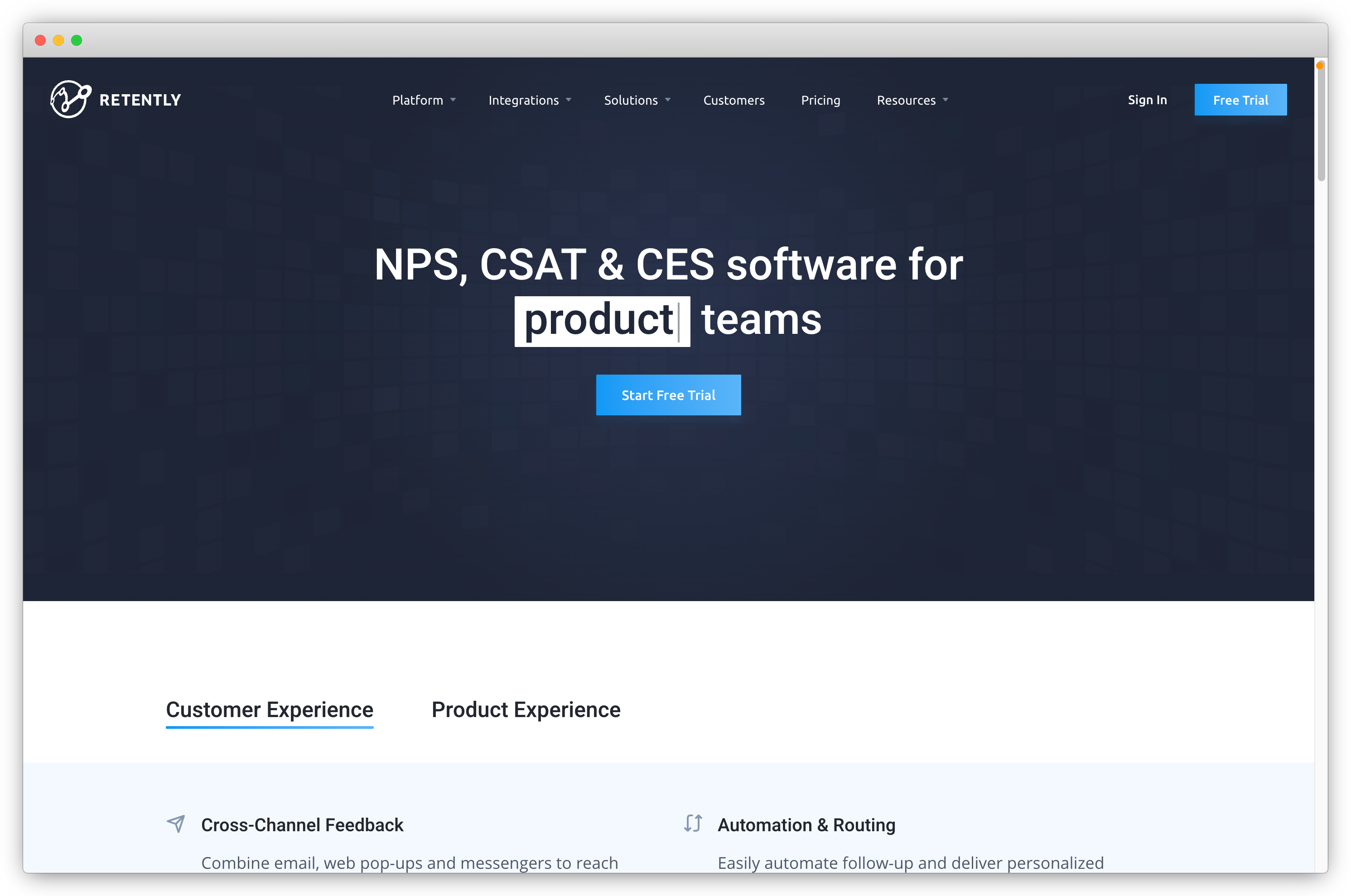
Retently is an all-encompassing customer feedback tool that excels in delivering a comprehensive suite of features tailored to enhance customer satisfaction and loyalty. This feedback tool positions itself as a comprehensive solution, covering the entire spectrum of customer feedback management. Its emphasis on integration, analytics, and personalized experiences makes it an ideal choice for businesses committed to elevating their customer satisfaction strategies.
Not only does it help analyze customer feedback but is also one of the best customer feedback tools enabling businesses to capture and make the most of user insights.
Key Features
- NPS, CSAT & CES Omnichannel Surveys
- Feedback Management & Collaboration
- Integrations with CRM, Customer Success & Email Marketing
- Advanced Reports & Analytics
- Provides industry benchmarks, allowing businesses to contextualize their performance against industry standards
- Automation and routing capabilities, streamlining the feedback collection process
Pros
- Offers sentiment analysis to analyze customer feedback
- Segmentation and targeting to target specific customer groups
- Automates actions like sending follow-up emails based on survey responses
Cons
- Limited survey types with primary focus on NPS, CES, and customer satisfaction surveys
- Customization options for surveys and reports are limited
Rating
4.6
Free Option
The tool offers a 7-day free trial to all its users. However, there are no free plans.
23. Refiner
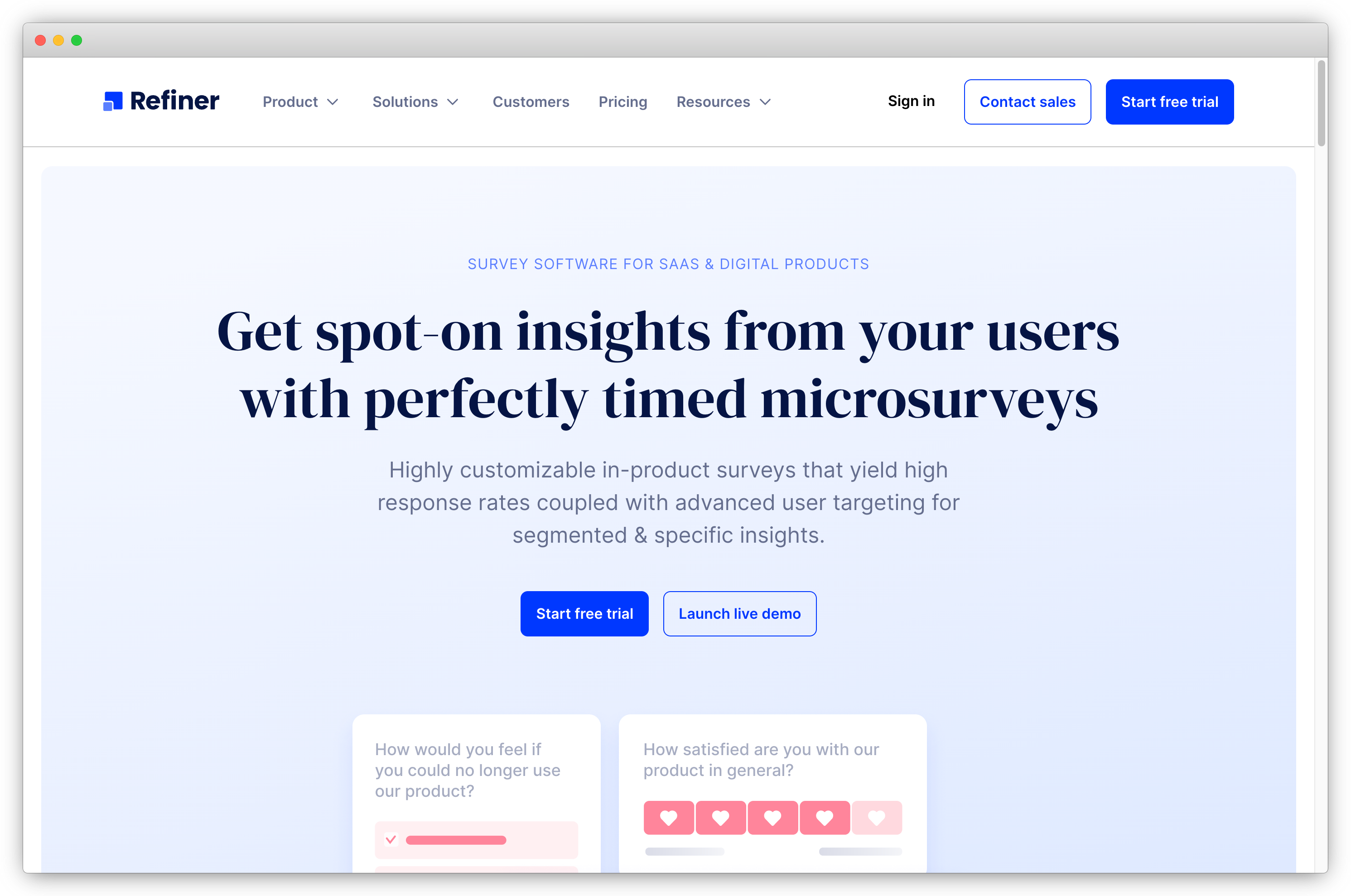
Refiner is a dynamic customer feedback tool designed to empower businesses with actionable insights and a deeper understanding of customer sentiments. With a focus on flexibility and ease of use, Refiner enables organizations to implement diverse feedback strategies, measure customer satisfaction, and drive continuous improvements across the customer journey.
This customer feedback platform offers a range of features to cater to diverse customer feedback needs. Its emphasis on flexibility, integration, and advanced analytics makes it an ideal choice for businesses committed to elevating their customer satisfaction strategies.
Key Features
- NPS, CSAT & CES surveys
- Seamless feedback management & collaboration
- Integrations with CRM and marketing tools
- Cross-channel feedback collection
- Automation & routing
- Personalized experiences & follow-up
Pros
- Helps to build an admin panel where survey data can be visualized and managed
- Custom dashboards within the admin panel to display survey results
- Efficient workflows for internal teams
Cons
- Limited customization options for survey design
- Some users report issues with the user interface being less intuitive
- Pricing can be on the higher side for smaller businesses or those with limited budgets
Rating
4.5
Free Option
The tool offers a free trial with major basic features for a month.
How to Choose the Best Tool to Collect Customer Feedback?
Choosing the right customer feedback tool isn’t just about software features—it’s about finding a solution that fits your business goals, integrates seamlessly into your workflow, and delivers actionable insights. The right tool should help you collect, analyze, and act on feedback in real time, ensuring continuous improvements to customer experience.
Here are some key factors to consider when selecting a customer feedback tool:
1. Define your Feedback Goals and Use Cases
Before selecting a tool, be clear on what insights you need and how you’ll use them.
- What type of feedback do you want to collect? (NPS, CSAT, CES, in-app surveys, post-support feedback, website feedback, etc.)
- What are your goals? (Improve product features, enhance customer service, reduce churn, optimize website experience, etc.)
- Who will be using the tool? (Marketing, customer support, product team, developers, etc.)
💡 Tip: Choose a tool that does more than just one thing. A platform that only supports a single feedback channel or has strict limitations may work for your current needs but could restrict your growth later. Look for flexibility—something that allows you to expand as your business evolves.
2. Identify Must-Have Features
Your tool should be easy to use, flexible, and continuously evolving. Make sure it includes:
- Survey Builder – Supports customizable surveys with logic, branding, and multilingual options.
- Omnichannel Feedback Collection – Enables feedback via email, SMS, WhatsApp, website, chatbots, kiosks, and mobile apps.
- AI-Powered Analytics – Includes sentiment analysis, text analytics, and automated insights to make feedback more actionable.
- Reporting & Dashboards – Tracks trends, analyzes NPS over time, and generates detailed reports.
- Automation & Workflows – Automates follow-ups, routes issues to the right team, and helps close the feedback loop.
- Integrations – Syncs with CRM, helpdesk, and business tools like Salesforce, HubSpot, and Zendesk.
💡 Tip: Feedback tools should keep evolving with new features. Check their release notes or ask about their product roadmap. SaaS tools that actively roll out updates and improvements will grow with your business needs, ensuring your tool doesn't become outdated.
3. Set a Budget & Compare Pricing
Customer feedback tools come with different pricing structures—some are subscription-based, others are pay-as-you-go. Free tools always come with limitations, whether it’s survey caps, missing features, or lack of integrations.
- What pricing model does the tool offer? (Subscription, pay-as-you-go, tiered plans)
- Are there any free plans or trials available?
- Are there any hidden costs? (Add-ons for integrations, extra users, or advanced analytics)
💡 Tip: Instead of focusing on free plans, choose a tool that provides the most value. Investing in a solid feedback system ensures better insights, automation, and long-term benefits for your business.
4. Assess their Ease of Use and Support
A complex tool with a steep learning curve can slow down adoption. Ensure the tool is user-friendly and has reliable support.
- Is the tool intuitive and easy to navigate?
- Does it offer self-service options like help docs, tutorials, and knowledge bases?
- Is customer support responsive? (Live chat, email, phone support, and availability across time zones)
5. Additional Factors to Consider
While features, pricing, and ease of use are crucial, there are other key aspects that impact the long-term success of your feedback program. Make sure your chosen tool meets these essential criteria:
- Security & Compliance – Ensure the tool complies with GDPR, ISO 27001, or other data protection regulations to protect customer data.
- Scalability – Can the tool scale with your business as feedback volume grows?
- Reputation & Reviews – Check user ratings on G2, Capterra, and Trustpilot to understand real customer experiences.
- Custom Integrations – If the tool doesn’t integrate natively with your stack, can the team build custom solutions?
- Trial Period & Demo – Test the tool with a free trial or request a demo to see if it fits your workflow before committing.
By carefully evaluating these factors and aligning them with your business needs, you can choose a customer feedback tool that goes beyond just collecting responses. The right tool will help you understand customer sentiment, drive meaningful improvements, and close the feedback loop effectively. Investing in a feature-rich, scalable, and AI-powered feedback system ensures that your business continuously adapts to customer needs—enhancing satisfaction, boosting loyalty, and reducing churn in the long run.
Conclusion
Choosing the right customer feedback tool is key to understanding customer sentiment, improving experiences, measuring customer service and and driving loyalty. A tool that scales with your business, offers omnichannel feedback collection, AI-driven insights, and automation ensures you take action—not just collect responses.
Zonka Feedback stands out as a powerful platform to capture insights, close the feedback loop, and turn feedback into real growth. Book a demo to see it in action. 🚀
FAQs About Customer Feedback Tools
This section answers common questions about customer feedback tools to help readers make informed decisions:
1. What is a customer feedback tool?
A customer feedback tool is software that helps businesses collect, analyze, and act on customer opinions, suggestions, and complaints. It enables companies to understand customer sentiment, improve experiences, and close the feedback loop. Feedback can be gathered via surveys, website widgets, SMS, email, chatbots, or in-app pop-ups.
2. How is a customer feedback tool different from a survey tool?
A survey tool is primarily used to create and distribute surveys, while a customer feedback tool offers end-to-end feedback management—including multi-channel collection, AI-powered analysis, automation, and actionable insights.
- Survey Tools: Create and distribute surveys, collect responses, and generate basic reports.
- Customer Feedback Tools: Do everything a survey tool does plus sentiment analysis, case management, closing the feedback loop, and automation.
💡 Tip: If you’re only running one-off surveys, a survey tool might work. But if you want to track customer experience trends, improve satisfaction, and reduce churn, invest in a full customer feedback tool.
3. At what stage of my business should I invest in a customer feedback tool?
Right from the start. Even small businesses benefit from understanding customer sentiment early to improve products, service, and retention.
- Startups & Early-Stage Businesses – Collect real-time feedback from early adopters to refine your product and customer experience.
- Growing Businesses – Track NPS, identify pain points, and optimize processes before scaling operations.
- Established Enterprises – Automate feedback workflows, integrate with CRMs, and drive customer loyalty through data-driven improvements.
💡 Tip: The sooner you start collecting feedback, the better you can identify trends, refine your strategy, and reduce churn before it impacts growth.
4. How much do customer feedback tools typically cost?
Pricing depends on features, scale, and customization needs:
- Free Plans: Basic features with limited surveys, responses, or analytics.
- Subscription Models: Typically $20–$200/month for small to medium businesses, including integrations and automation.
- Enterprise Pricing: Custom quotes for large-scale businesses needing advanced analytics, AI, and security compliance.
💡 Tip: Free tools have limitations—consider long-term scalability when selecting a platform.
5. What are the key ROI indicators for customer feedback tools?
To measure the return on investment (ROI), track these key performance indicators (KPIs):
- Customer Retention & Churn Reduction: Identify and resolve customer pain points before they lead to churn.
- Improved NPS & CSAT Scores: Monitor feedback trends over time to measure satisfaction.
- Reduced Support Costs: Address recurring issues proactively using feedback insights.
- Revenue Growth: Better customer experiences increase loyalty, repeat purchases, and customer lifetime value (CLV).
- Operational Efficiency: Use feedback data to streamline workflows and reduce inefficiencies.
6. How do I choose the right customer feedback tool?
To select the best tool for your business:
- Define Goals: Are you collecting feedback for product improvements, service quality, or customer satisfaction (NPS, CSAT, CES)?
- Check Features: Look for survey customization, AI-driven analytics, and automation capabilities.
- Ensure Scalability: Choose a tool that can grow with your business.
- Evaluate Integrations: Make sure it connects with your CRM, helpdesk, and marketing tools.
- Consider Usability & Support: Opt for a tool that is easy to use, provides good customer support, and offers onboarding assistance.
7. Are customer feedback tools easy to integrate with existing systems?
Yes, most modern tools seamlessly integrate with CRM platforms (Salesforce, HubSpot), helpdesk software (Zendesk, Freshdesk), and email marketing tools. Ensure the tool you select supports API access, webhooks, and native integrations for streamlined workflows.
8. What types of feedback can I collect using these tools?
Customer feedback tools allow businesses to collect various types of feedback, including:
- Transactional Feedback: Post-purchase or post-support experience surveys.
- Product Feedback: Customer input on features, usability, and enhancements.
- Website Feedback: UX feedback, bug reports, and exit intent surveys.
- Employee Feedback: Internal feedback on processes and engagement.
- Brand Perception Surveys: Measuring customer loyalty through NPS, CES, and CSAT.
9. Can AI improve customer feedback analysis?
Yes, AI-powered feedback tools provide deeper insights by:
- Sentiment Analysis: Automatically detecting customer emotions in feedback.
- Thematic & Topic Analysis: Grouping responses into trends without manual sorting.
- Predictive Insights: Identifying patterns in customer satisfaction to prevent churn.
- Automated Workflows: Triggering follow-ups based on negative or urgent feedback.
💡 Tip: AI reduces manual effort and helps businesses focus on what matters most—improving customer experience.
10. What’s the difference between NPS, CSAT, and CES?
- NPS (Net Promoter Score): Measures long-term customer loyalty by asking, "How likely are you to recommend us?"
- CSAT (Customer Satisfaction Score): Gauges satisfaction with a specific interaction or service.
- CES (Customer Effort Score): Evaluates how easy it is for customers to resolve issues or complete actions.
💡 Tip: NPS is ideal for long-term brand perception, while CSAT and CES are better for transactional feedback.
11. What are the biggest mistakes businesses make when using feedback tools?
- Collecting feedback but not acting on it.
- Choosing a tool without omnichannel capabilities.
- Ignoring AI and automation for large-scale analysis.
- Not integrating feedback data into business workflows.
- Focusing on free tools without long-term scalability.
12. Why should I choose Zonka Feedback?
Zonka Feedback is an AI-powered customer feedback platform that allows businesses to collect feedback through multiple channels, automate workflows, and close the feedback loop in real time. It offers:
- Customizable surveys & omnichannel collection (email, SMS, WhatsApp, website, kiosks)
- AI-driven sentiment analysis & predictive insights
- Real-time alerts & automated follow-ups
- Deep CRM & helpdesk integrations
Book a demo and see how Zonka Feedback can transform the way you manage customer experience!











